Northern Norway: A Family Journey Through Heritage and Arctic Wilderness
As part of a two-week family adventure that included time in Sweden and Finland, we spent one week exploring northern Norway, focusing on the breathtaking Senja Island and the rarely visited Øvre Dividal National Park.
Returning to Norway for New and Old Reasons
This was my third trip to Norway, each with a unique purpose:
-
My first visit was a personal journey—tracing my heritage, visiting the towns where my ancestors once lived, and meeting living relatives who shared stories of our family’s past.
-
My second trip took me to the Arctic archipelago of Svalbard, immersing me in a stark, icy wilderness unlike anywhere else on Earth.
-
And now, this trip—my first in the summer months—was a chance to experience the lush fjords, dramatic mountains, and pristine Arctic mainland at their most vibrant.
A Special Trip for Indie
I was especially excited to bring Indie, my daughter, to Norway—a country she shares heritage with through me. There was something deeply meaningful about watching her experience the landscapes of her ancestral homeland, from the jagged peaks of Senja to the endless summer light of the far north.
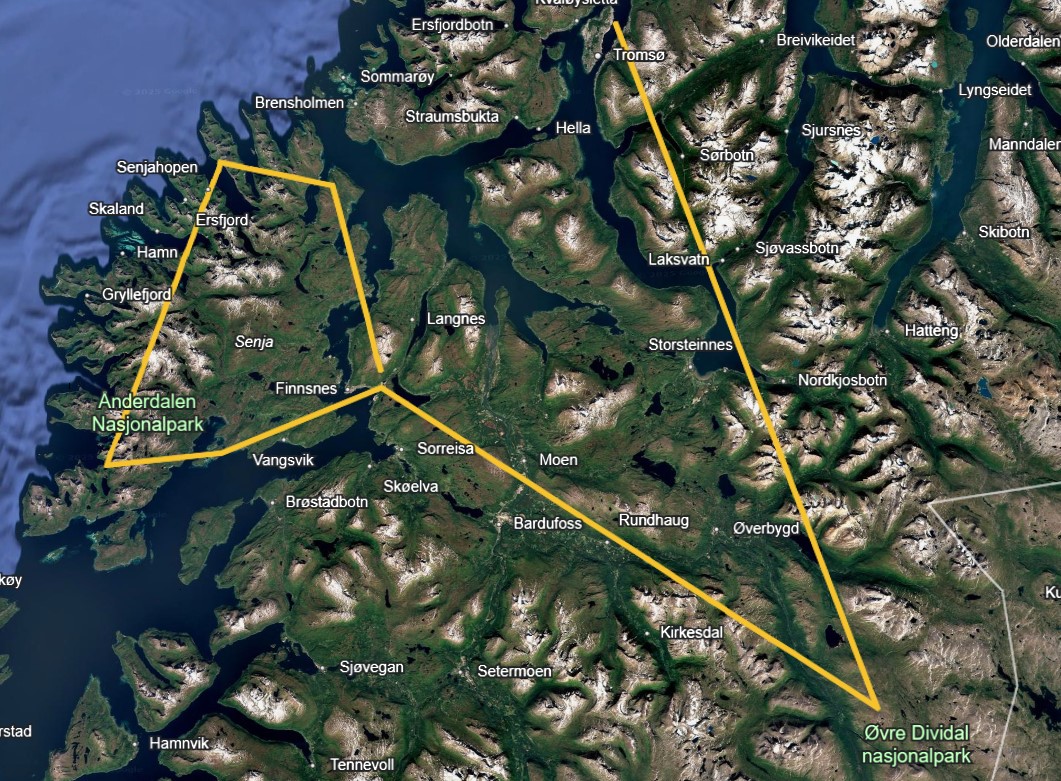
Our route in Norway
Arrival in Tromsø: A Flight Fiasco and Midnight Sun
To reach Tromsø, we flew directly from Helsinki with Finnair. But what should have been a straightforward connection turned into a stressful ordeal.
We nearly missed our flight because Finnair claimed one of our tickets had been issued incorrectly by United Airlines’ mileage program, while United insisted Finnair made the error—and neither side took responsibility.
After a lot of tense back and forth, the issue was finally sorted out—just in time.
But it was a stark reminder of why I always say:
Arrive at the airport early. You never know when you’ll need every minute.
First Night in the Land of the Midnight Sun
We arrived in Tromsø in the evening, rented a car, and drove into the city to our hotel in the old town, near the picturesque waterfront.
Though it was late, the sun never set—and wouldn’t for the entire week—thanks to how far above the Arctic Circle we were.
It was surreal to see the city bathed in perpetual daylight, a phenomenon that would define our entire stay in Norway’s far north.
Return to Norway – Now With Indie
A Personal Journey Comes Full Circle
It was surreal to be back in Norway—a country I’ve visited before and one that holds a special family connection for me. But this time felt different. It wasn’t just about fjords, reindeer, or the midnight sun.
This time, I was here with my daughter, Indie.
Arrival in Tromsø: Calm, Cold, and Comfortably Familiar
Tromsø Airport was just as I imagined it—sleepy and calm. Within minutes of landing, we had picked up our rental car, which surprisingly didn’t feel like the typical wallet-destroying Norwegian transaction.
-
Rental car cost: surprisingly affordable
-
Model: a brand-new Toyota RAV4—the same one we drive at home
With keys in hand, we set off toward our hotel—the Comfort Inn, tucked along the harbor in Tromsø’s old town.
Parking in a Cave (Literally)
Despite the city streets being nearly deserted, finding parking was a challenge. Eventually, I drove down into a massive cave-like underground parking structure—one that seemed to tunnel endlessly into the mountain. It was:
-
Cold
-
Echoing
-
Dimly lit
-
And absolutely surreal
It might be the most unique parking lot I’ve ever used anywhere in the world.
Exploring Tromsø on Foot
We wasted no time. With Indie bundled up and camera in hand, we stepped into Tromsø’s evening air. It’s a city built for walking—compact, charming, and full of little surprises.
Just a few blocks from the hotel, we stumbled across a restaurant that stopped us in our tracks. Not because it served Norwegian fare—but because of its name.
🍛 Dinner at “Indie”
It wasn’t reindeer stew or cod we ended up having. It was Indian food.
The restaurant was called Indie—yes, the same as our daughter. Between the name, the beautifully exotic Indian décor, and the delicious smell wafting from the kitchen, we couldn’t resist.
-
The food? Expensive, like everything in Norway.
-
The ambiance? Warm, colorful, and photogenic.
-
The reaction? Total joy—we couldn’t stop taking pictures of Indie next to everything that had her name on it.
A Sweet Coincidence
As we wrapped up our meal, we told our waitress that our daughter was named Indie. She smiled and paused for a moment before saying:
“That’s the second child named Indie who’s eaten here today.”
Earlier that afternoon, a Norwegian family had dined at the same table—with their own daughter Indie in tow.
We had never met another child with her name. What are the odds?
And then she added with a grin:
“Your Indie was better behaved. The other one knocked over a glass and broke it.”
A Memorable First Night
Tired, full, and smiling from an unexpectedly perfect evening, we made our way back to the Comfort Inn. The midnight sun still lingered on the horizon, as if even the Arctic was curious to see how our journey would unfold.
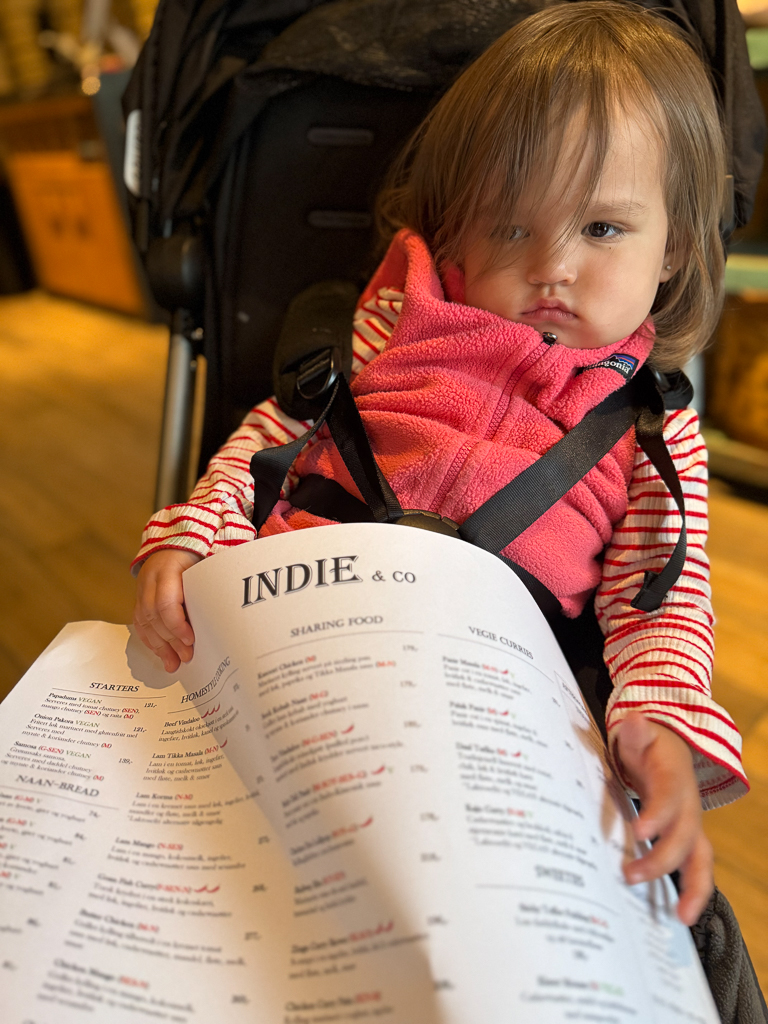
Indie eating at the Indie restaurant
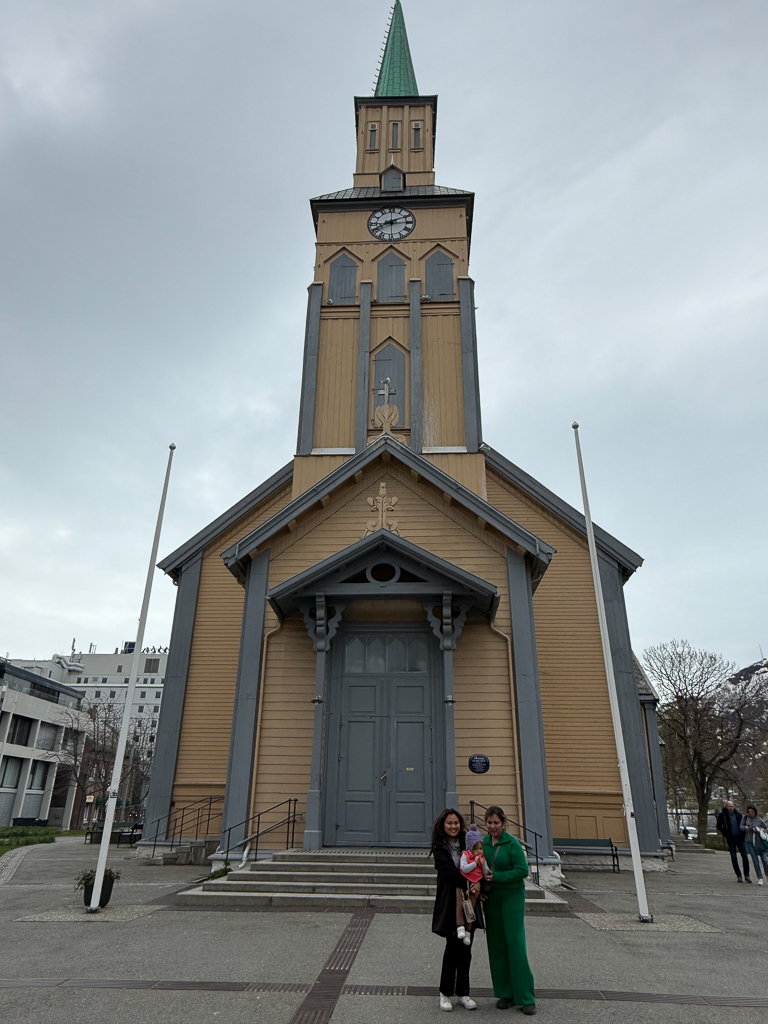
Family photo in front of the church
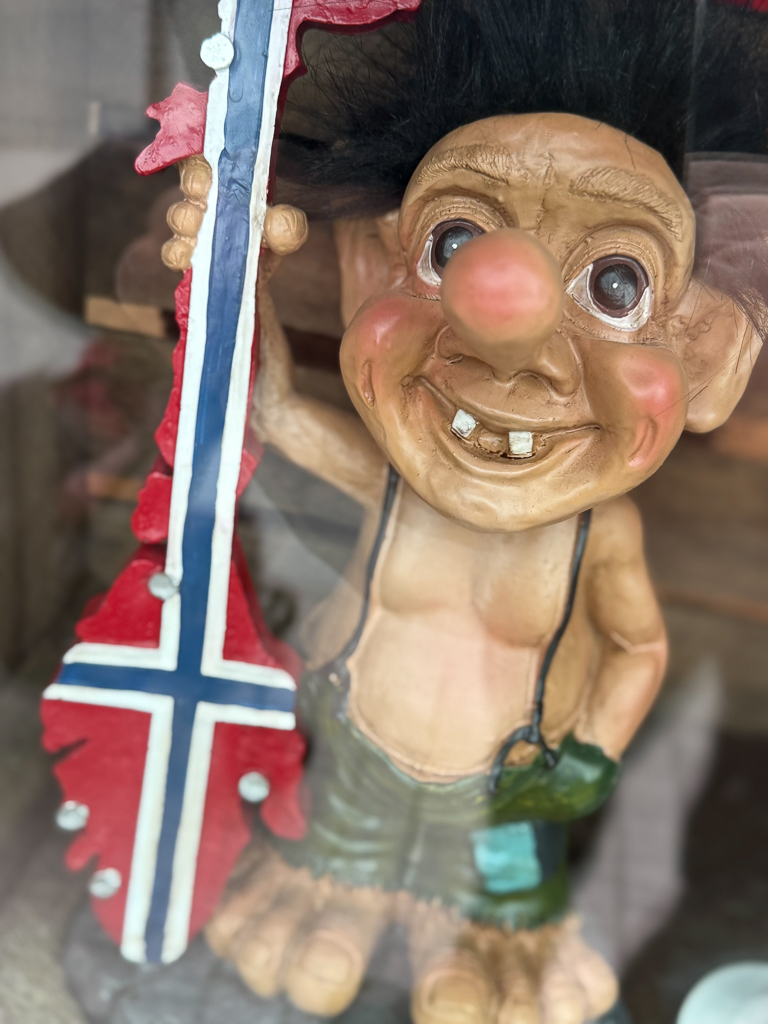
Norwegian troll
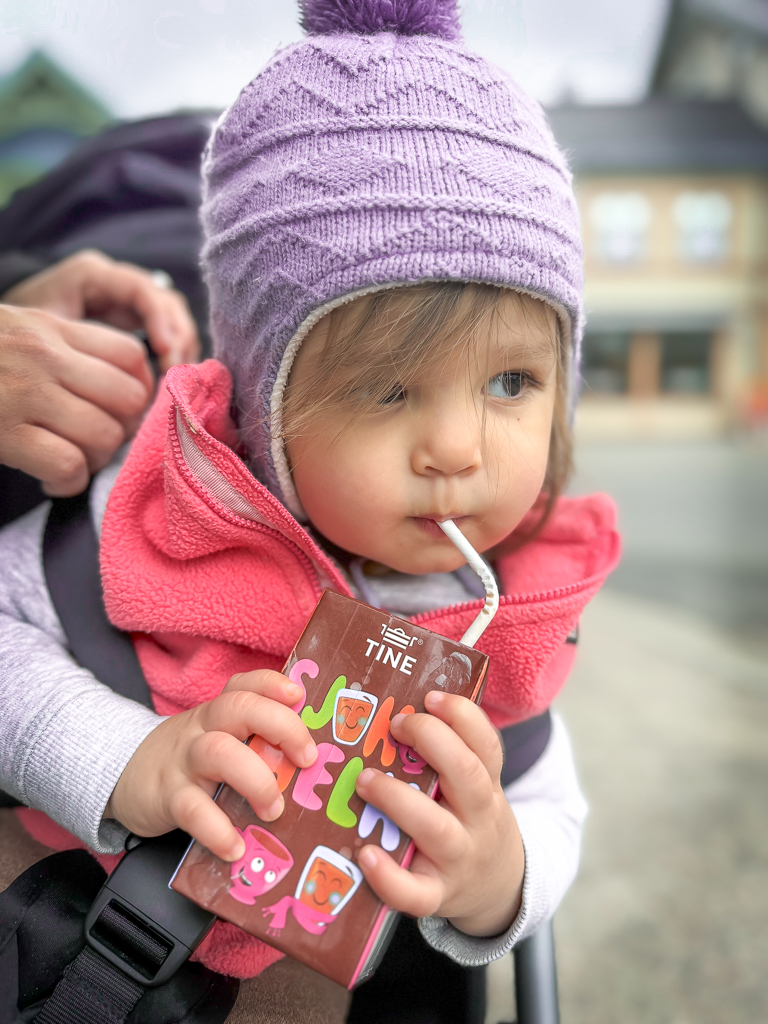
Indie having Norwegian chocalate milk
From Chaos to Calm: Leaving Tromsø for the Wilds of Øvre Dividal
A Rough Start in Tromsø
Our second morning in Norway was anything but idyllic. The hotel room was stifling hot, and the window refused to open—something we’d quickly learn was surprisingly common throughout Scandinavian hotels. Without any air conditioning, it felt like we had woken up inside a sauna.
Things got worse in an instant. As I was closing the bathroom door, Indie, always curious and always moving, placed her tiny fingers right into the hinge. The door closed. Then came the sharp cry—and the terrifying thought that she might have broken them. In those few seconds, time froze. But to our immense relief, after a short bout of tears and a lot of worry, she was fine. No swelling. No breaks. Just one very frightened pair of parents.
Grocery Stop Before the Wilderness
Still shaken but grateful, we packed the car and made a quick stop at the local grocery store before leaving Tromsø. We knew restaurant prices would only go higher the further we got from town, so we picked up a few simple things to tide us over—some bread, cheese, fruit, and a few other staples. Grocery stores in Norway are no bargain, but compared to eating out, it felt like a practical choice.
Onward to Øvre Dividal
Our next destination was a remote cabin on the edge of Øvre Dividal National Park, a wild, sprawling preserve that stretches along the Swedish border. It’s one of Norway’s least-visited national parks, known for its dramatic mountains, glacial valleys, and old-growth pine forests.
As we left Tromsø behind, the landscape unfolded into something out of a dream. Northern Norway’s beauty revealed itself kilometer by kilometer—deep fjords reflecting the sky, wooden farmhouses tucked into green hillsides, sleepy fishing villages with views that seemed painted on.
Despite the rough start, the drive began to soothe us. The further we went, the quieter everything became, until all that was left was the hum of tires on the road and the sense that we were heading toward something wild, something real, something entirely our own.
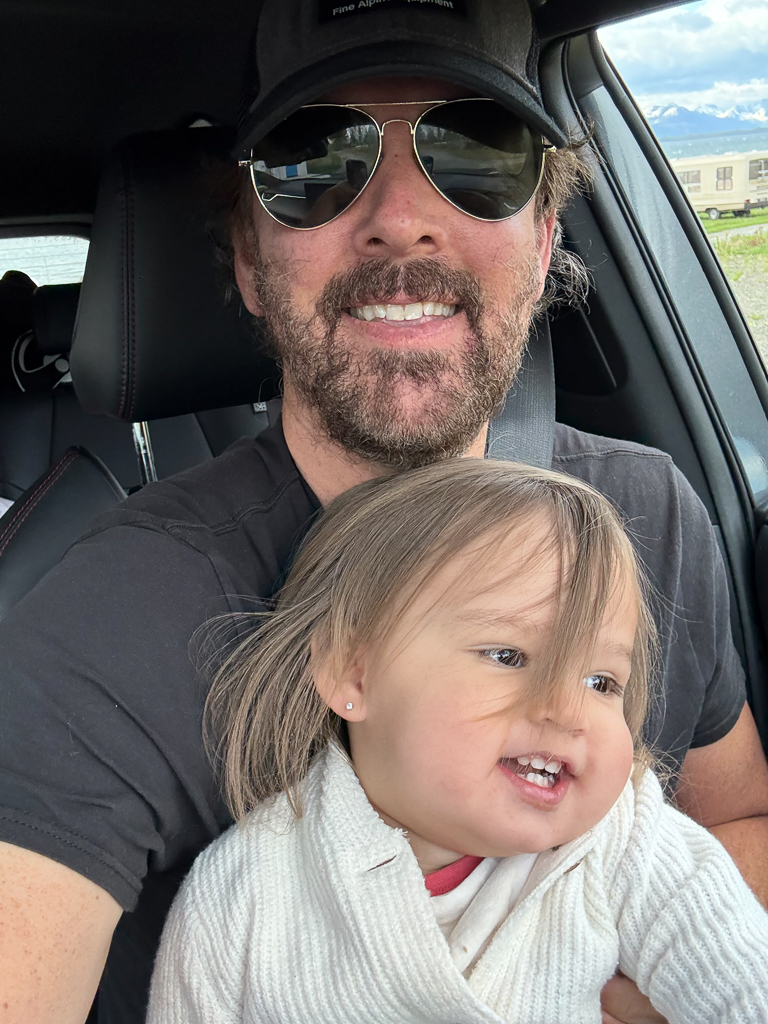
Indie sitting on my lap wanting to drive on our Norwegian road trip
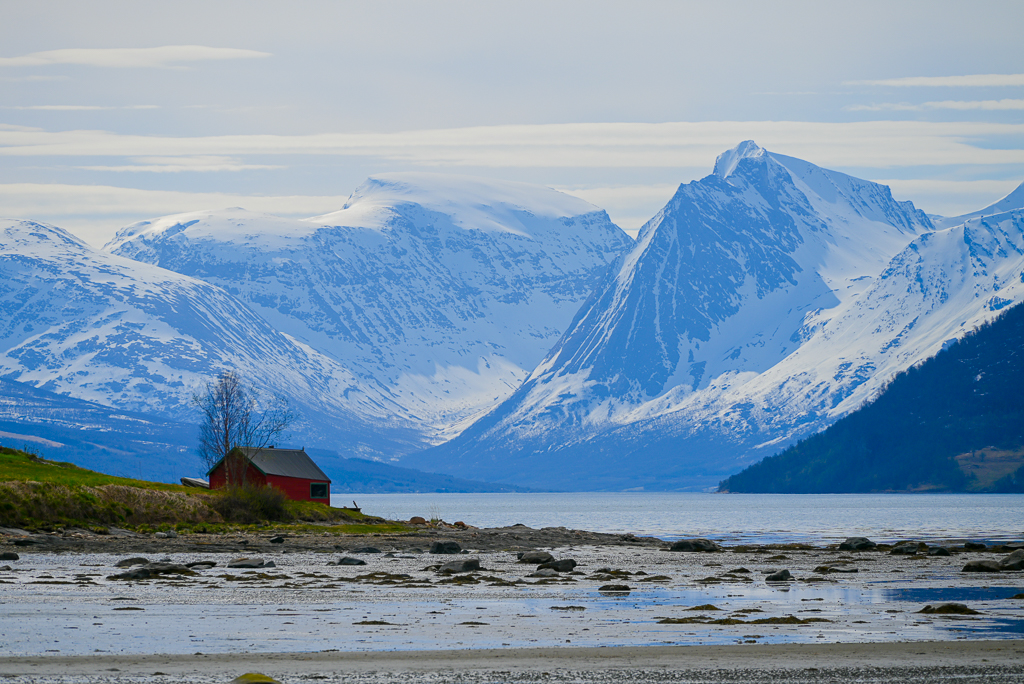
Beautiful fjord we stopped to see on the way
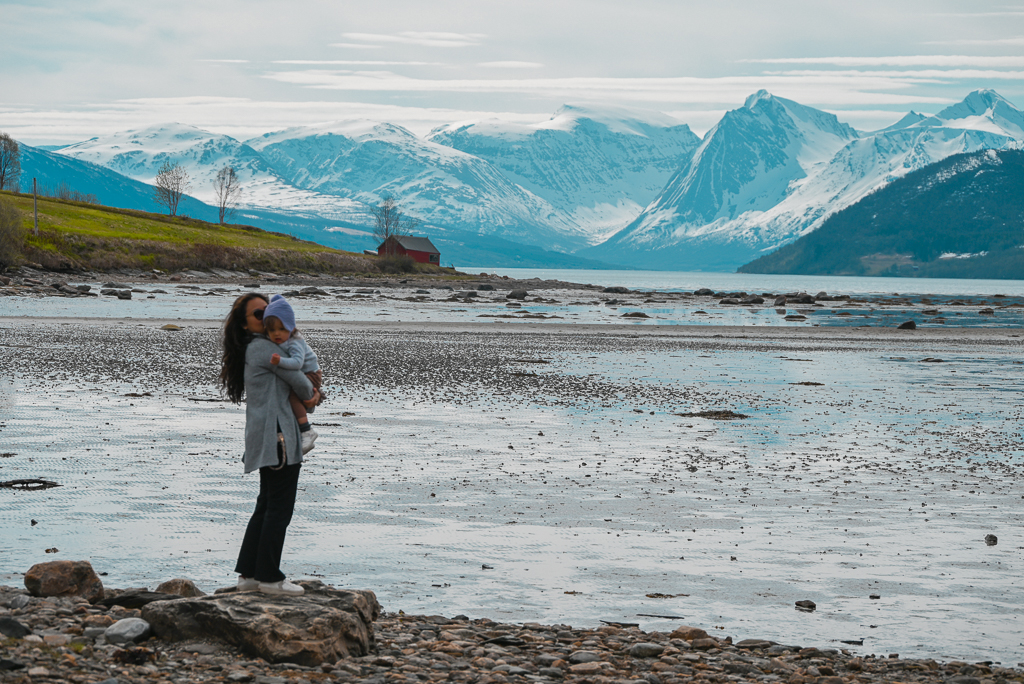
Paula and Indie at a fjord
Reindeer Roads and Rooftop Meadows
Following the Fjords—and Climbing Above Them
As we continued our drive toward Øvre Dividal, the road began to climb. One moment we were winding gently along the mirrored surfaces of quiet fjords, and the next we were heading up into high alpine passes, where the air felt thinner and colder.
Up there, between snow-dusted ridges and stretches of tundra, we began to see them: reindeer.
They grazed casually along the roadside, unbothered by passing cars. Some stood alone on rocky outcrops, while others roamed in small groups, their antlers backlit by the soft northern light. These weren’t wild reindeer—they almost certainly belonged to Sámi reindeer herding communities, who have stewarded these animals and this land for centuries.
Signs, but No Moose
There were plenty of road signs warning of moose crossings, their silhouettes looming large and proud. We kept our eyes peeled, hoping for a glimpse of one, but the moose remained elusive. Reindeer, on the other hand, were everywhere—at times wandering right into the road and forcing us to slow down.
Villages of Red and Green
As we descended back into the lower valleys, the road led us through a scattering of tiny, picturesque villages—the kind of places that seem to whisper stories of generations past. I found myself pulling over constantly to photograph the old red barns and wooden houses with grass-covered rooftops.
The contrast was striking: vivid red walls beneath soft, rolling tufts of green. But these charming colors were not chosen just for beauty.
The deep red paint on the barns was originally made using copper-rich pigments, which were inexpensive and highly effective at preserving wood through Norway’s long, punishing winters. Even today, long after modern paint has taken over, many still use that traditional red out of respect for the past.
And then there were the rooftops blanketed with thick grass, a living layer of insulation. Before modern heating and insulation, grass and sod roofs were an essential method of retaining warmth through the frigid, snowbound months. They still survive today—sometimes out of necessity in remote places, but often out of pride in tradition.
What struck me most was the size of many of the barns. They weren’t just picturesque—they were huge. These buildings weren’t designed just for storage. Their large size served a critical function: they needed to hold enormous hay piles for the winter and to shelter farm animals from the bitter Arctic cold. In many cases, livestock and supplies were kept under the same roof, protected together against snowstorms and subzero temperatures.
These barns weren’t just buildings—they were lifelines.
A Road That Tells a Story
This stretch of the journey felt like more than just a drive—it was a moving museum of old traditions, still very much alive in the modern north. Between the grazing reindeer, the red barns, and the turf-roofed homes, we were surrounded by a landscape full of quiet history—beautiful, practical, and still deeply connected to the people who call it home.
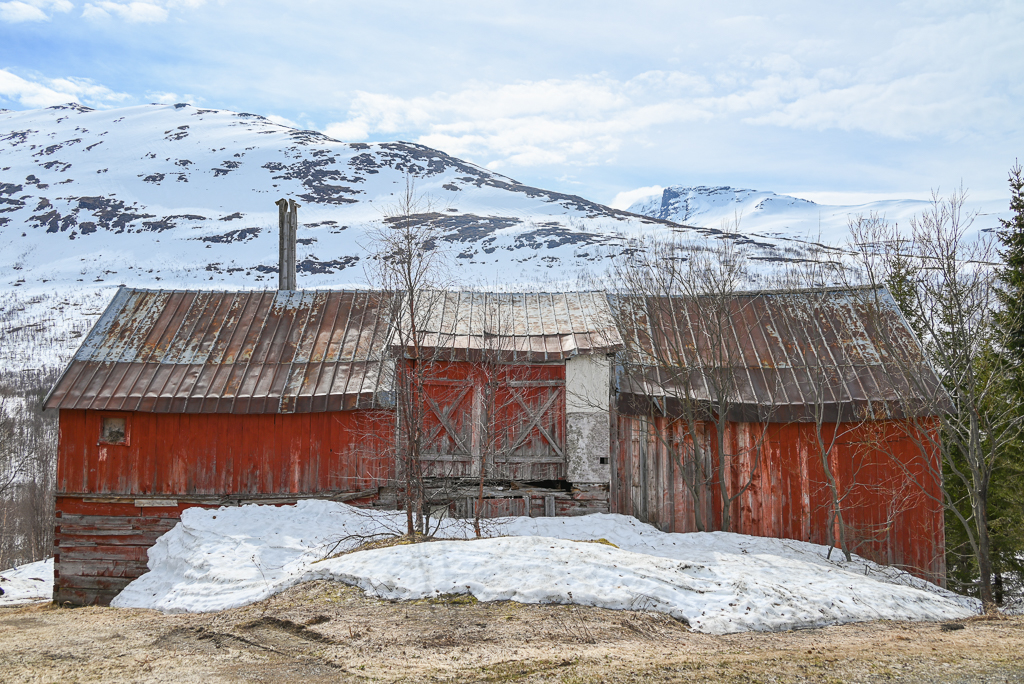
Old red barn
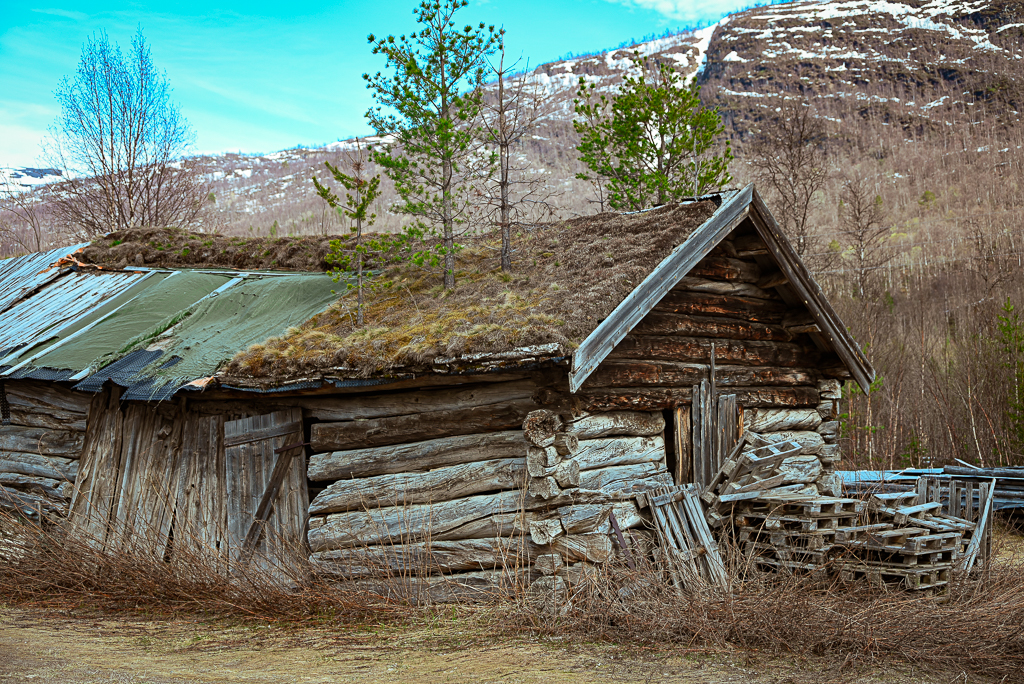
Old house with sod on top and a tree growing
Into the Wild: Øvre Dividal National Park
Why Øvre Dividal?
Of all the places I considered visiting in northern Norway, Øvre Dividal National Park stood out. It wasn’t just its raw beauty or its remoteness—it was the feeling that this place still belonged to the wilderness, a rare thing in a world so mapped and paved over.
I had read that Øvre Dividal has the highest density of wolverines in the world—a fact that hooked me instantly. These elusive, tough-as-nails predators are notoriously hard to spot. But just knowing we were in their territory added a thrilling edge to the landscape. The park is also home to bears and wolves, though sightings are rare and usually reserved for the extremely patient or lucky.
Sámi Land, Still Alive
The land here isn’t just wild—it’s also deeply cultural. Øvre Dividal is part of the traditional reindeer herding grounds of the Sámi people, Norway’s Indigenous community. There are Sámi villages near the park, and though many Sámi now live modern lives, indistinguishable in dress or daily routine from other Norwegians, they still hold onto unique customs, beliefs, and traditions.
Reindeer herding is one of those traditions, and it’s very much alive in this region. As we drove through the valleys and passed through the outskirts of the park, we saw wooden tepee-like structures—Sámi lavvus—used both for cultural ceremonies and practical shelter. These symbols of heritage stood quietly among the trees and by the rivers, a reminder that this landscape has been home to the Sámi for centuries.
A Cabin in the Middle of Nowhere
Because it was still late spring—and still too cold for any serious hiking with a toddler—we kept our ambitions simple. I figured we could at least do some short walks into the forest, dip our feet into the edges of the park, and just maybe catch a glimpse of something wild. That alone would be enough.
To make it easier, I booked a remote cabin on the edge of the park. It was affordable, especially by Norwegian standards, and though it was in the middle of nowhere, it came with exactly what I hoped for: silence, solitude, and scenery.
From our windows, we could see the river winding through the valley and the snow-capped mountains rising around us like watchful giants. It felt like we had stepped out of time—into a world both ancient and untouched.
This wasn’t the kind of trip where you check things off a list. It was the kind where you slow down, listen, and let the landscape seep into your bones.
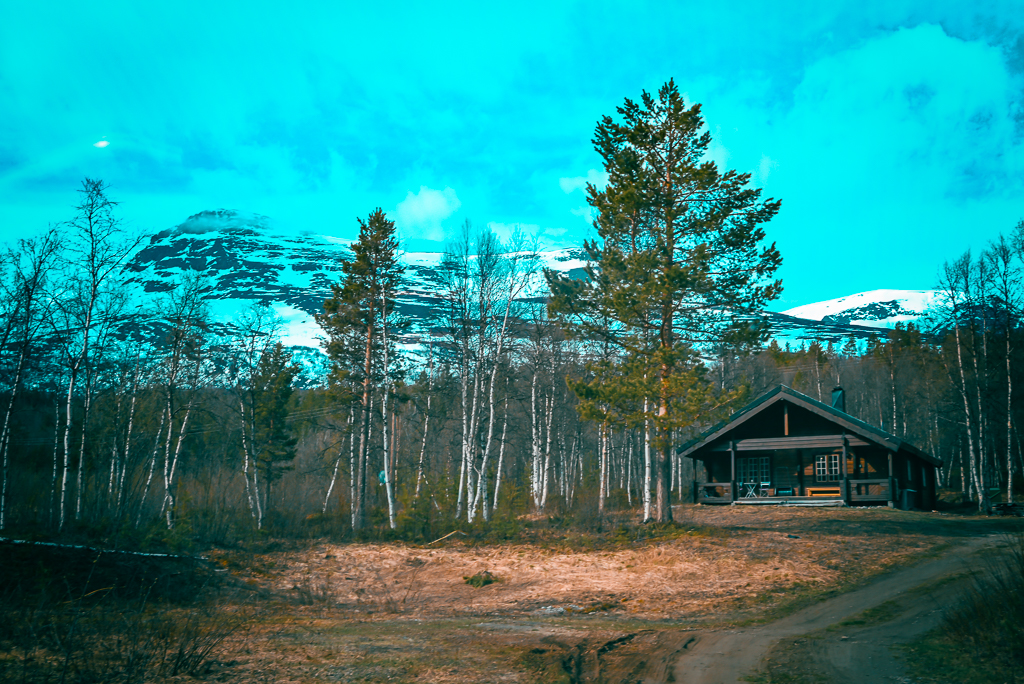
Our cozy Norwegian cabin in Ovre Dividal where we spent an hour re-arranging everything to baby-proof it against Indie
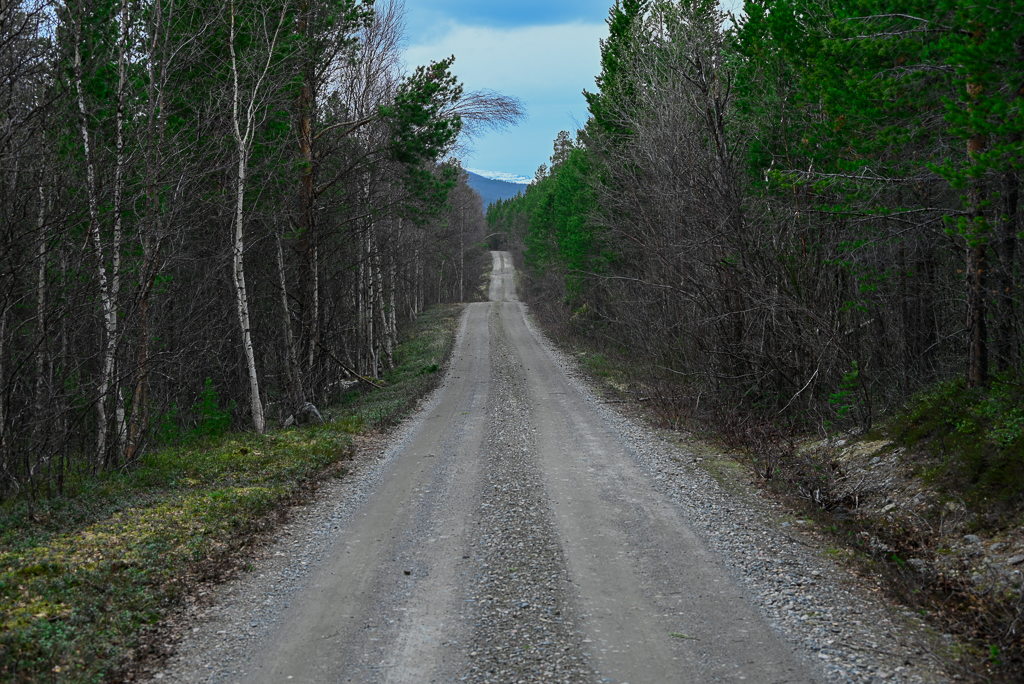
Gravel road into Ovre Dividal National Park. The park was so seldom visited that I would on occasion have to get out of the car and move a small tree that had fallen blocking the road
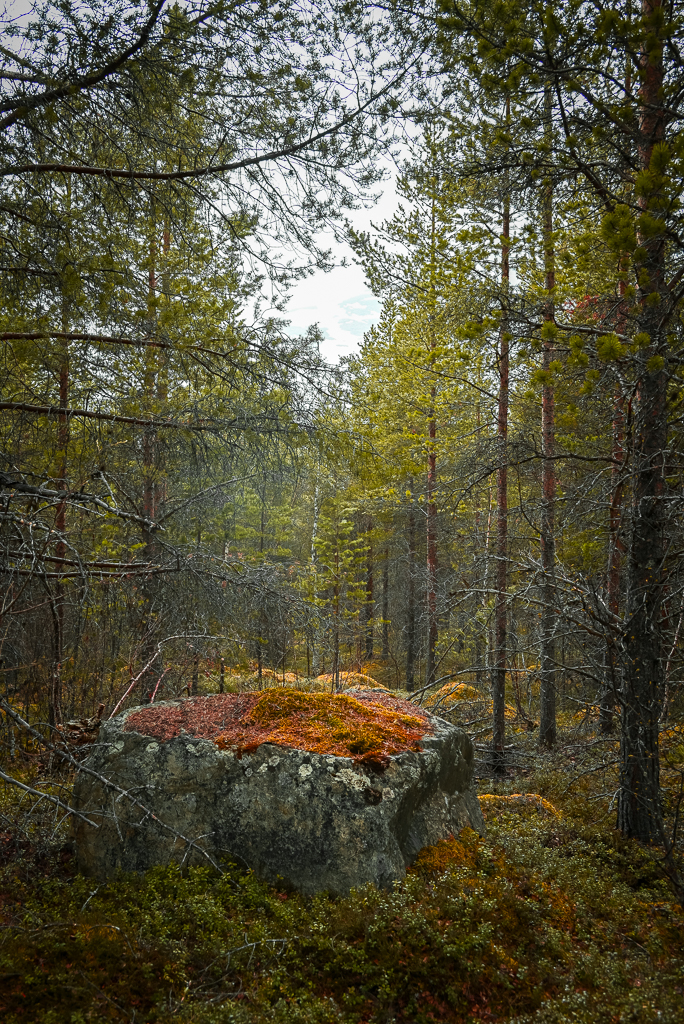
Old growth forest
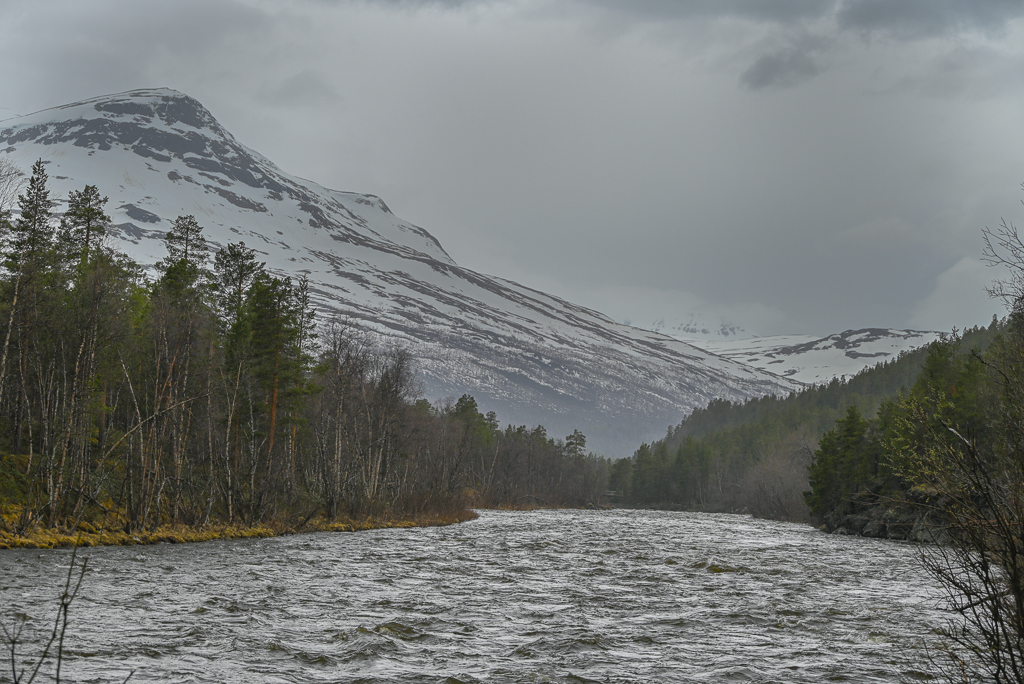
The river was high with spring snow melt and in some areas raging with rapids
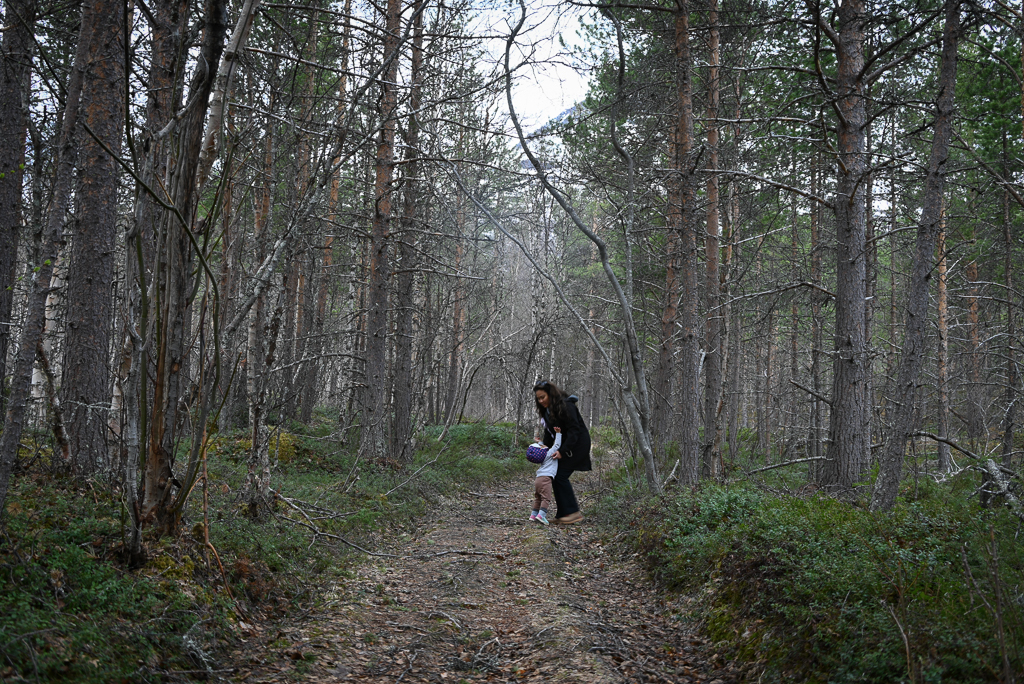
Hiking with Indie
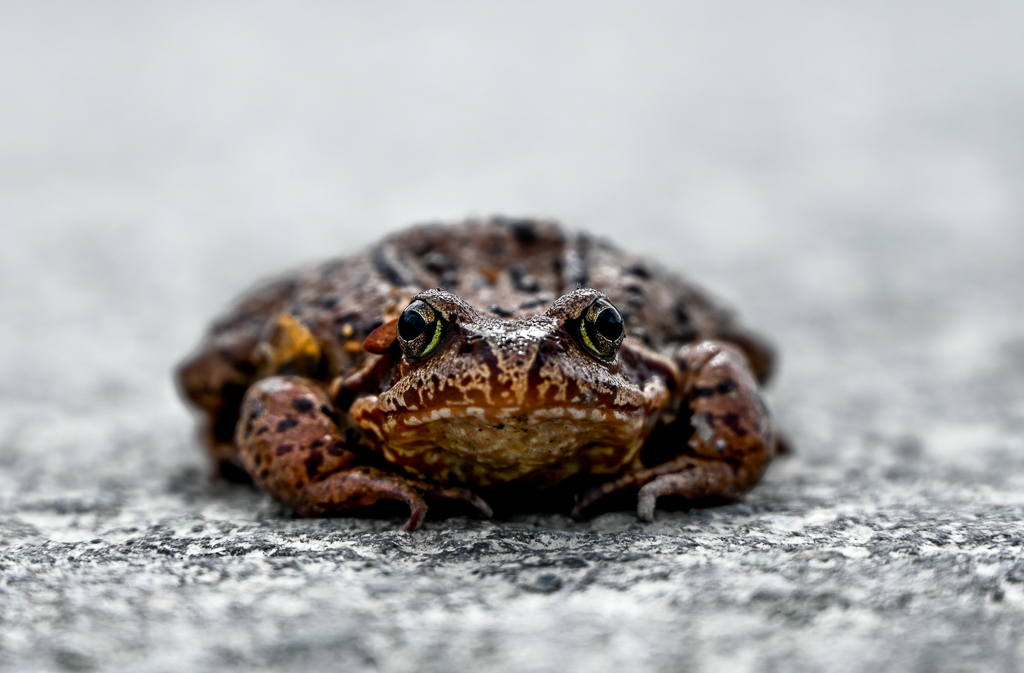
A Norwegian toad I rescued from the center of the road and relocated into a bush
Into the Heart of Senja: Where Midnight Sun Meets Wilderness
Leaving Øvre Dividal
After a quiet night in our remote cabin on the edge of Øvre Dividal, we packed up and said goodbye to the wild, silent valleys and the snow-lined peaks that had cradled us in solitude. It was a short stay, but the sense of space, of untouched nature, would stay with us long after we left.
From there, we began the next leg of our journey toward what I had long expected to be the highlight of the entire trip: Senja Island.
Why Senja?
Senja isn’t exactly a secret, but it still feels like one. It has the jagged fjords, turquoise waters, and white-sand beaches that have made the Lofoten Islands world-famous—but without the tour buses and crowds. It’s cheaper, less polished, and more raw. That’s what drew me to it.
It’s a place where nature hasn’t been curated for visitors. It just is—wild, elemental, and overwhelmingly beautiful.
A Cabin on the Southwestern Shore
I booked us a traditional rorbu (fishing cabin) on the southwestern coast of the island, a quieter region with fewer jaw-dropping cliffs than the northeast, but still achingly beautiful in its own way. Our cabin sat right near the water, surrounded by thick forest and steep hills, with boats gently bobbing in the harbor outside our window.
It wasn’t fancy, but it was perfect.
It also came at a price that—by Norwegian standards—felt like a steal. That, combined with the peaceful setting, made it an easy decision to stay for three nights and use it as a base to explore.
Chasing Light in the Land of No Night
What made Senja truly magical wasn’t just the scenery—it was the light. In late spring, the sun never set. Even at midnight, the landscape glowed in soft, golden hues. There was no deadline, no pressure to rush.
We could nap in the afternoon, explore after dinner, or head out for a scenic drive at 10 p.m. and still feel like the day was just beginning.
Every day from our cabin, we’d set out to a new corner of the island—one day driving through winding mountain roads, the next following the shoreline past beaches and fishing villages. Sometimes we stopped for long, slow walks. Other times we just pulled over the car to soak it all in.
Senja didn’t disappoint. It wasn’t just a highlight of the trip. It was everything I hoped Norway would be—dramatic and humble, immense and intimate, a place that felt both wild and welcoming.
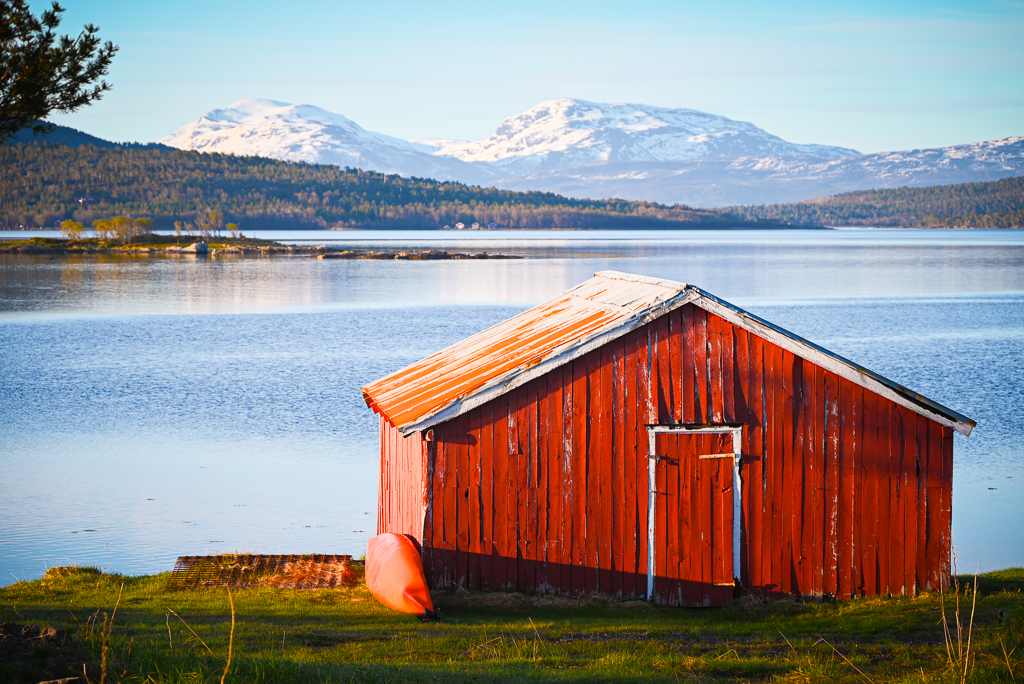
Fishing cabin on the fjord
A Cabin Built for Smurfs, Not Vikings
Finding a place to stay on Senja wasn’t easy. There aren’t a lot of accommodation options on the island, and most of the ones that do exist are—like everything else in Norway—pretty expensive.
So I was genuinely surprised (and relieved) to find a traditional fishing cabin available for a reasonable price. It wasn’t luxurious, and it certainly wasn’t built with modern travelers in mind. In fact, it seemed like it had barely been updated since the 1960s—and it was definitely built for smurfs, not Norwegian vikings.
The doorways were low. Comically low. I lost count of how many times I hit my head entering and exiting different rooms. And the bathroom wasn’t even inside—it was separate and shared, a little detail I’d overlooked when booking. But somehow, none of that really mattered.
Because outside, the setting was pure magic.
The cabin sat in a quiet harbor, with views out across the water and the mountains rising just beyond. Fishing boats creaked in the docks. The air smelled like seaweed and pine. And once the sun dipped low into the sky—but never quite disappeared—the light turned golden and stretched on forever.
Inside, it was warm and cozy. The walls creaked when the wind blew and the floor sloped slightly downhill, but it felt honest. This wasn’t a polished resort—it was a piece of working history, and for a few days, it was ours.
It may have been tight on headroom, but it was big on atmosphere—and in a place like Senja, that’s what really counts.
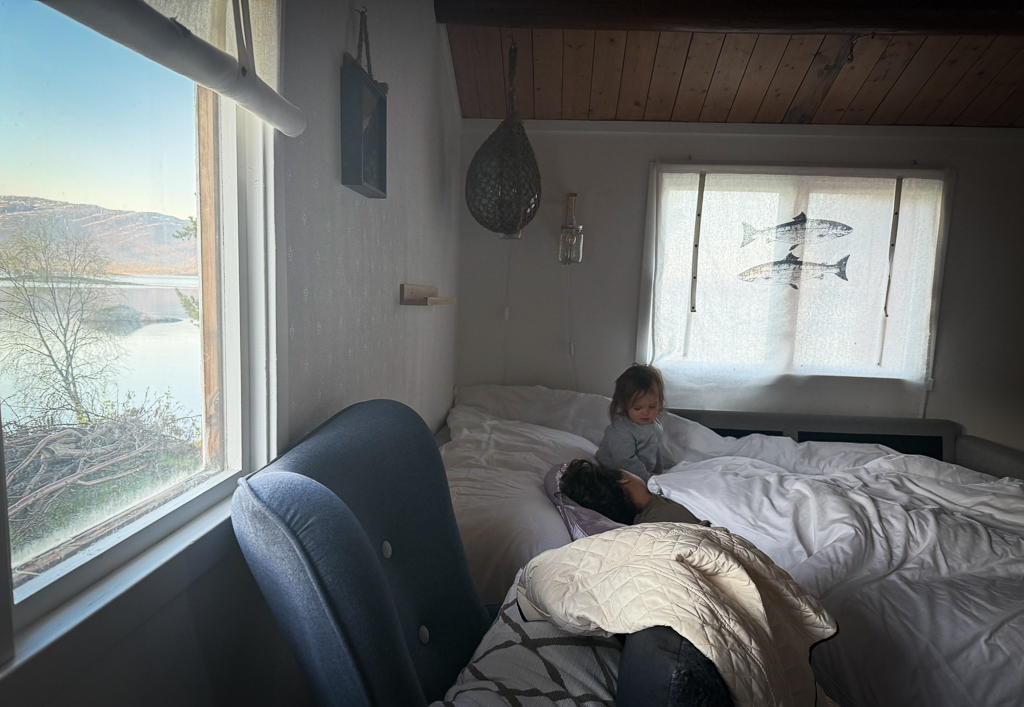
The couch we turned into our bed in our fishing cabin
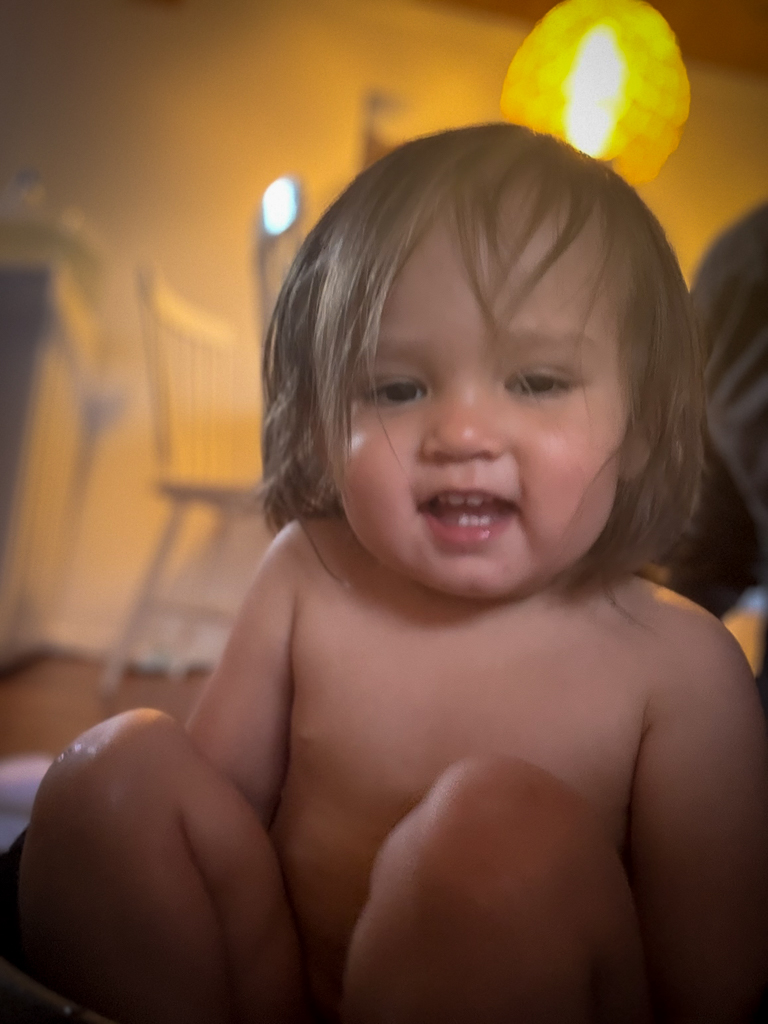
We didn’t have a bathroom, so we filled up a bucket to bathe Indie in our cabin

Momma and Indie sleeping in our cozy cabin where the sun never goes down at night
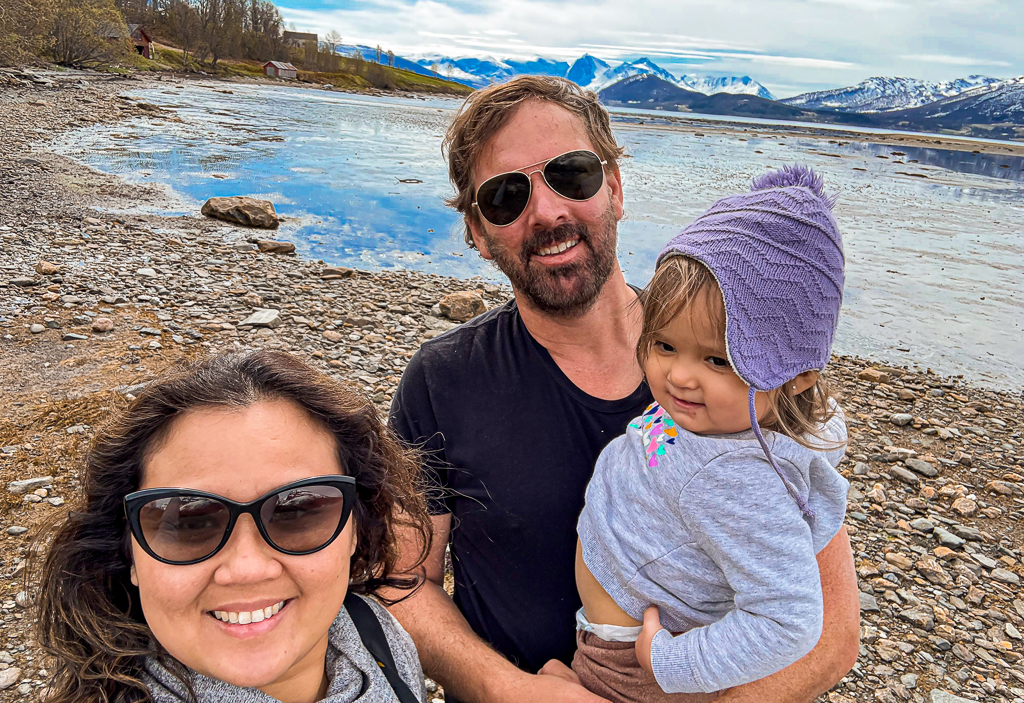
Exploring the shoreline by the cabin
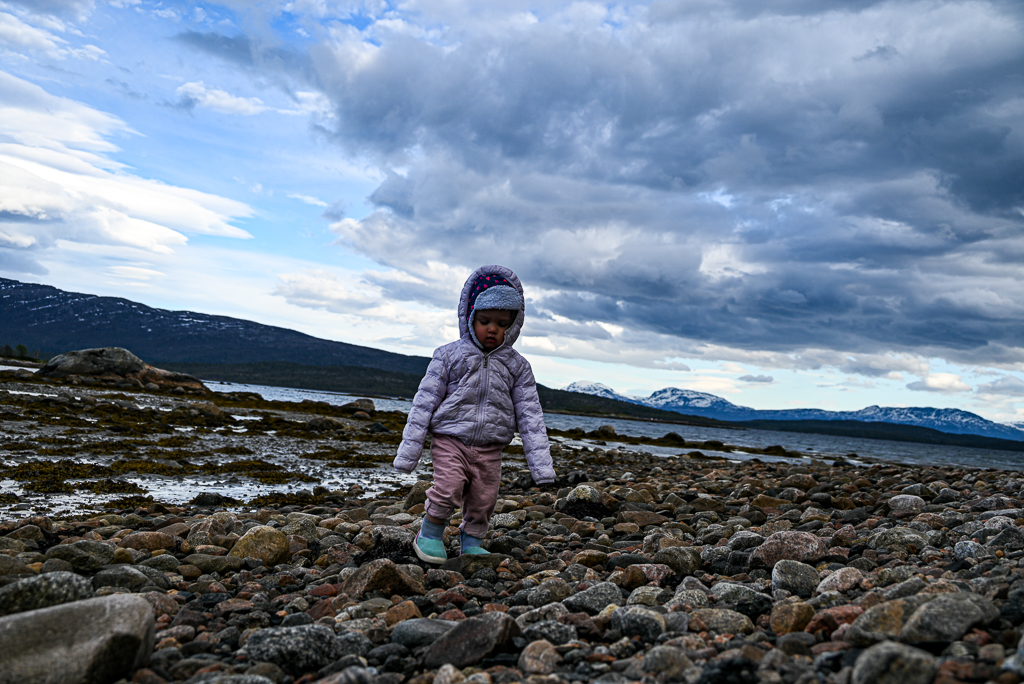
Indie walking along the low tide
Tunnel by Tunnel, Fjord by Fjord
Exploring this part of Senja means navigating a network of one-lane tunnels—long, dark, and occasionally nerve-racking. These aren’t polished, well-lit tourist tunnels. Some are narrow and dingy, with water dripping from the rock ceiling and minimal lighting. A few were so tight that we had to back up to allow an oncoming car to pass, pulling into tiny carved-out spaces like elbows in the rock.
One tunnel, in particular, took nearly 30 minutes to get through. It wound endlessly beneath the mountains, and with no signage, no radio reception, and no visibility ahead, it felt like descending into another world. Claustrophobic? Definitely. But it was also part of what made the journey feel so raw and real.
And it’s not without risk. We passed a massive rockfall just meters from the road—fresh and terrifying. In some of these isolated villages, there is literally only one way in and one way out, and that’s through one of these tunnels. If there’s an accident or a collapse, you’re stuck.
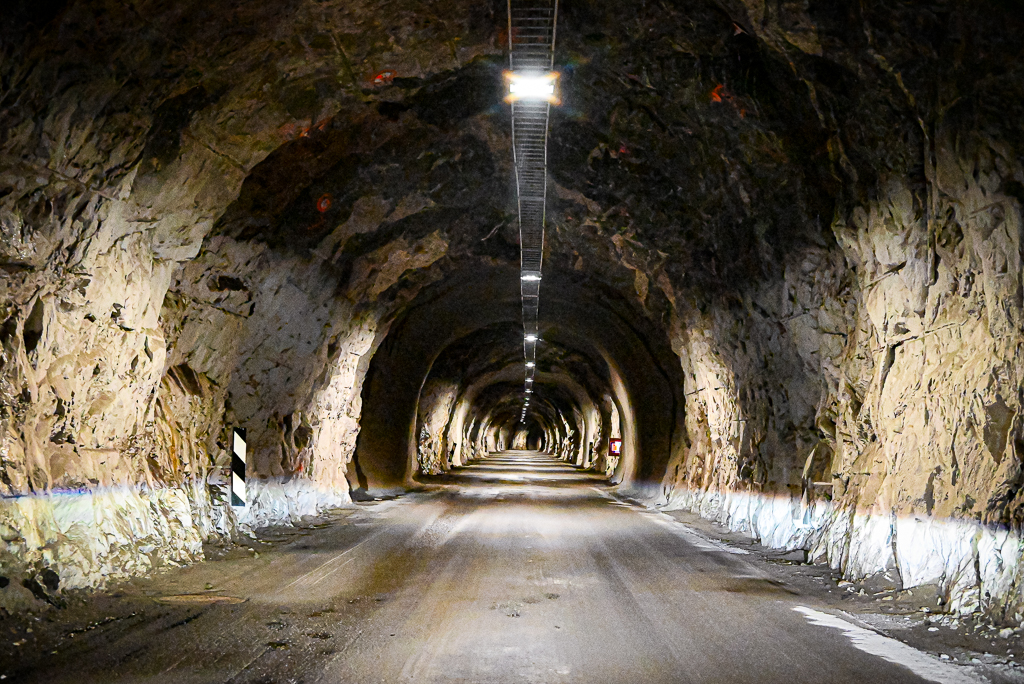
One of the many tunnels through the mountains in Senja Peninsula
Climbing Hesten: My Moment in the Mountains
I couldn’t come to a place as wild and breathtaking as Senja and not climb a mountain. Even with a toddler in tow, I knew I had to find something that struck the balance—a high-reward hike that was short enough that my family wouldn’t have to wait too long, but still packed with views that would make it all worth it.
That hike turned out to be Hesten.
It’s not a massive peak—just under 2,000 feet (about 600 meters)—but it delivers everything you could want from a climb in Arctic Norway. The trail begins in the small fishing village of Fjordgård, nestled among steep fjord walls, and quickly heads upward.
A Short Hike Into the Sky
The hike took me around three hours round trip, though I could’ve spent much longer just soaking it all in. The path climbed steadily up through muddy trails and snow-packed tundra, weaving along sheer cliffs that dropped more than a thousand feet straight down into the fjord. There were no guard rails, no fences, just the vast openness of the Arctic sky and rock underfoot.
At times, the going got tough. I punched through the snow more than once—waist-deep in some spots—grateful for good boots and momentum. But the higher I climbed, the more the landscape opened up, until I reached the rocky perch just below the summit.
The View of a Lifetime
From the top, I had a front-row seat to one of Norway’s most iconic sights: Segla.
It’s a towering rock monolith, rising like a stone fin from the sea with a sheer, El Capitan-like face that drops vertically to the fjord below. In perfect weather, with barely a cloud in the sky and just a few other hikers sharing the trail, I sat there quietly, looking out over the peaks, the sea, and the seemingly endless horizon of the Norwegian Arctic coast.
This was one of those rare moments of pure peace—the kind you chase with every hike, every flight, every hour spent planning a trip. I was in my element, completely in love with this wild, windswept place.
And best of all, I’d be back with my family by lunch.
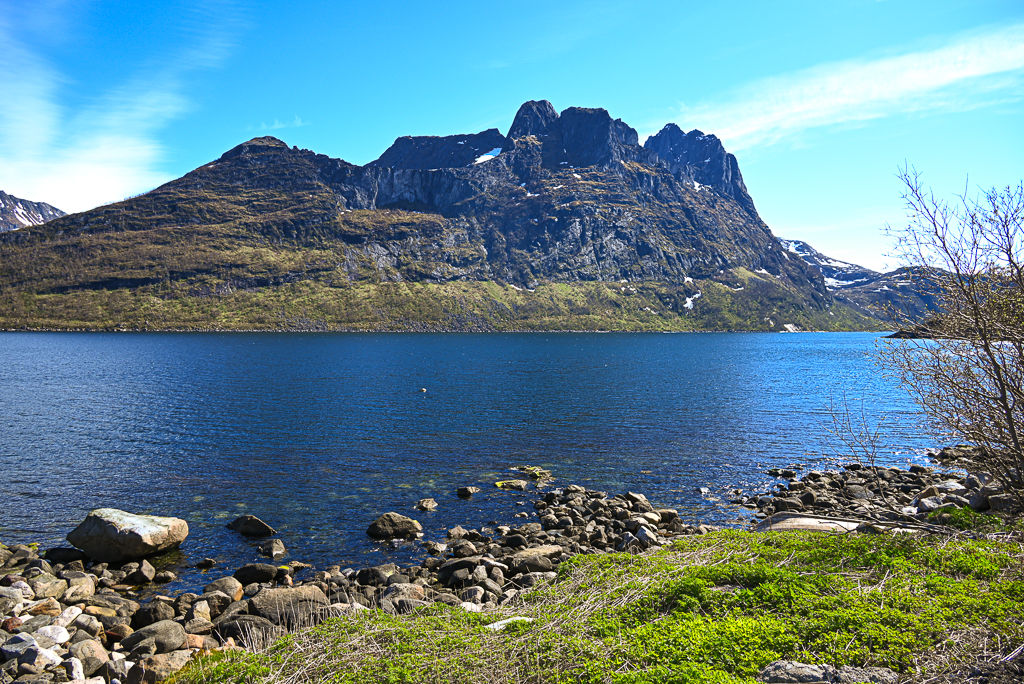
View from Fjordgard Village
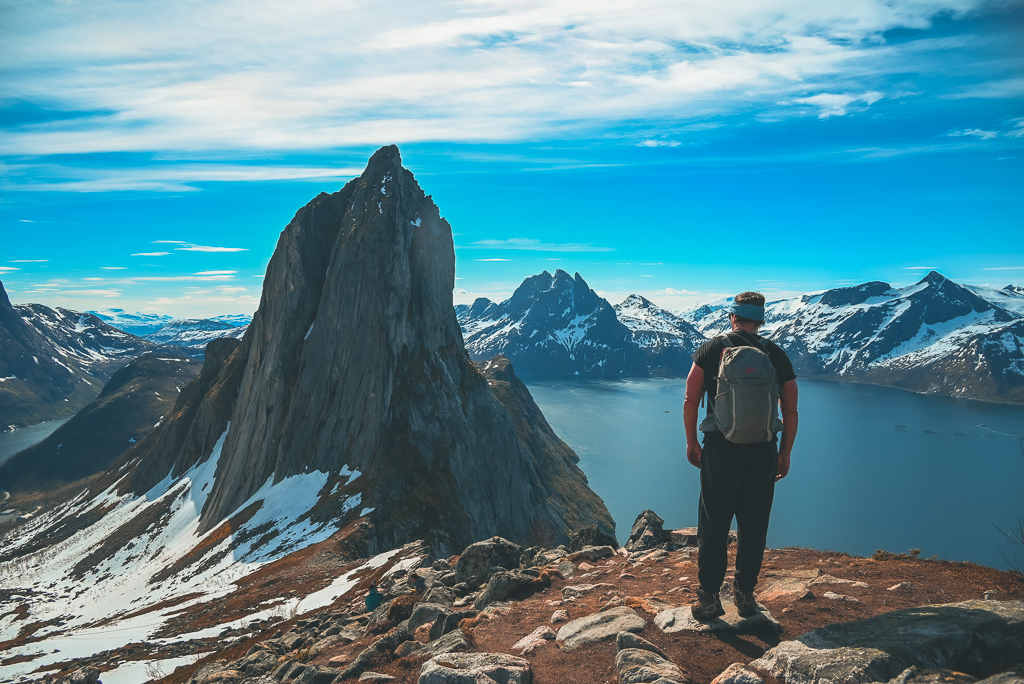
Me looking our over Segla Peak
A Misunderstanding in Fjordgård: When Worlds Collide
Fjordgård is tiny. A remote speck of a fishing village tucked into one of Senja’s many fjord-finger peninsulas, reachable only by narrow, one-lane tunnels bored through the mountains. It’s the kind of place where you feel like the outside world has simply stopped existing. And for a long time, I think it did.
But not anymore.
Senja isn’t swarming with tourists—not yet—but it’s slowly being discovered. Places like Lofoten have already become overwhelmed, and while Senja still holds onto its stillness, you can feel the shift coming. In villages like Fjordgård, where maybe 100 people live, it doesn’t take much to tip the scale. A few extra rental cars, a dozen hikers with cameras, and suddenly the peace begins to fray.
Even as a traveler who genuinely tries to be respectful and aware, I had a small taste of the tension that locals must feel.
A Mistake, a Misunderstanding
It happened after my hike up Hesten. I was hungry, tired, and my shoes were soaked from the snow. My family had dropped me off at the trailhead earlier, and now I was trying to track them down. I found them at a local store and coffee shop in town.
In the swirl of post-hike fatigue, I misunderstood where my wife told me the car was parked. I thought she said “behind the shop by the water”, and I figured she had parked there and paid a fee.
So I walked toward the waterfront parking lot, spotted a car that looked exactly like our rental RAV4, and tried to open the trunk—just to grab dry shoes.
That’s when I heard it—an aggressive knock on a nearby window. I looked up and froze. A woman inside was glaring out at me with fire in her eyes.
Suddenly, I realized: wrong car.
A Storm I Couldn’t Calm
Before I could even walk away, a furious elderly woman stormed out of the house, yelling at me in Russian. She was loud, furious, and made no effort to listen as I tried to explain.
“I thought it was my rental… I’m sorry—wrong car…”
She wasn’t hearing it. Her voice grew sharper, louder. Her face was locked in a look of disgust, not confusion. I backed away, hands up, and walked the few steps over to sit beside my wife and Indie—just ten feet away.
But the woman wasn’t done.
She stormed into the shop, animated and loud, talking with the store owner. I couldn’t understand her words, but the tone made it clear: she was debating whether to call the police. I tried once more to explain, to bridge the gap, but she only threw her head back in disgust, grunted, and walked off.
Later, my wife clarified that the car was actually parked in the marina lot, a half-mile down the road.
Oops.
The Weight Behind the Rage
In that moment, I felt like a jackass. But as I sat there watching the woman fume, I realized—her rage wasn’t really about me. This wasn’t just a misunderstanding over a car trunk. It was something deeper.
It felt like years of frustration boiling over, the weariness of watching strangers show up in what used to be a quiet, private village. People parking wherever they want, snapping pictures of every boat and barn, sometimes clueless, sometimes entitled. And I, for a few unlucky minutes, became the symbol of all that.
In a world where mass tourism is growing exponentially, bringing inconsiderate foreign tourists into conflict with locals—especially in small towns long accustomed to peace and tranquility, or in big cities where housing prices and the cost of living are being driven up—I get it. I really do. If I were in her shoes, I’d probably be frustrated too.
Maybe she didn’t speak English. Or maybe she did and just didn’t care. I noticed she was yelling at me in Russian, and later I would learn that many Russian immigrants have settled in northern Norway, particularly in these fishing communities, drawn by the shared maritime heritage and proximity to the Russian border. That detail helped the moment make a little more sense—a clash of languages, cultures, and bad timing, all compacted into a single misunderstanding.
I wish we could have cleared it up. I hate leaving situations like that with unnecessary strife hanging in the air. But sometimes, especially in someone else’s home, the best thing you can do is just leave—quietly, respectfully, and with your own frustration in check.
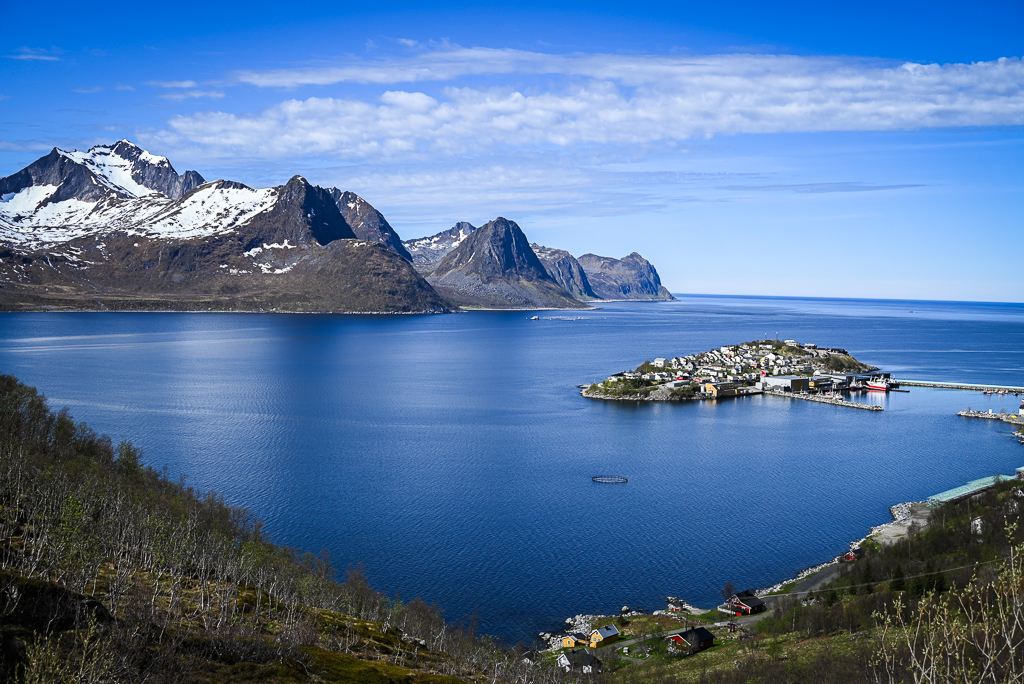
Husoy Island
A Visit to Husøy Island: Beauty Without the Buzz
Our next stop was Husøy, a small historical fishing island tucked into one of Senja’s deep fjords and connected to the mainland by a single bridge. It’s the kind of place that feels quietly forgotten by time—no postcards, no souvenir shops, no tour buses. Just salty air, weathered buildings, and the sea on all sides.
To be honest, there’s not much to “do” on Husøy, and that’s exactly why I liked it.
We took a leisurely walk toward the lighthouse, where the sunny weather gave us sweeping views out over the water. Indie found a small preserved wooden fishing boat along the way, and like any toddler, she immediately turned it into a jungle gym, climbing and exploring like she owned it.
The houses here were old, some perched right at the water’s edge, clinging to the rocks like they had been placed there by hand generations ago. A few had been updated, but most looked like they had seen decades of salt and storms.
Tolerated, Not Welcomed
Like many of the small towns on Senja, Husøy didn’t feel like it was trying to attract tourists. There was no clear signage, no restaurants or cafés aimed at visitors, and not much in the way of infrastructure. And honestly, that was fine with me.
It felt real—a functioning fishing village, not a re-created one.
But I could also feel a certain tension in the air. Not hostility exactly, but a sense that visitors were tolerated rather than welcomed. And in some ways, that made sense. When a town of a hundred people suddenly gets visitors from a dozen different countries wandering around taking photos of their homes and boats, it must feel invasive—especially when it’s clear the town never asked for that attention.
Still, I prefer places like this—the ones that haven’t been polished and packaged for mass tourism. Places that still feel authentic, and maybe even a little indifferent to outsiders.
Fjords, Tunnels, and Endless Stops
After Husøy, we continued our drive along the northern coast of Senja, following the deep-cut fjords that define this landscape. We stopped often—sometimes just to stare, sometimes to photograph the glassy waters, sharp peaks, and the odd tiny farm clinging to impossible hillsides.
We passed through more one-lane tunnels, some of them carved roughly through mountain rock, still unlit, and still intimidating. At one point, we entered a tunnel that seemed to spiral like a corkscrew through the dark. Each time we emerged, it was like being reborn into a new stretch of landscape—new light, new sky, new view.
These were the roads less traveled, and they delivered exactly what we had come for.
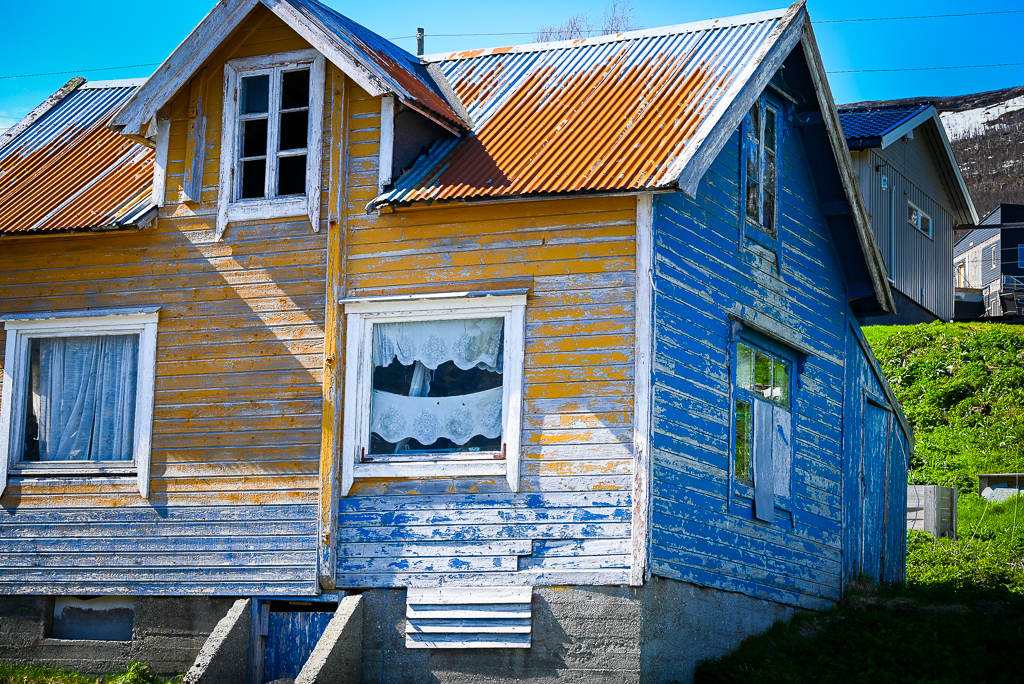
Small cottage on Husoy Island
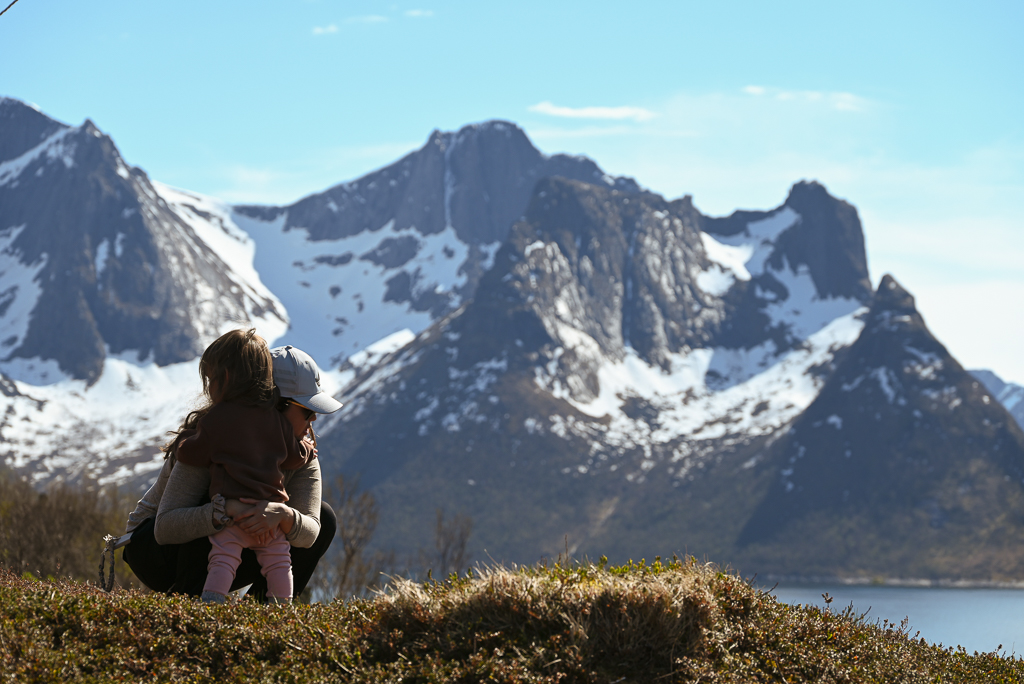
Lighthouse walk on Husoy island
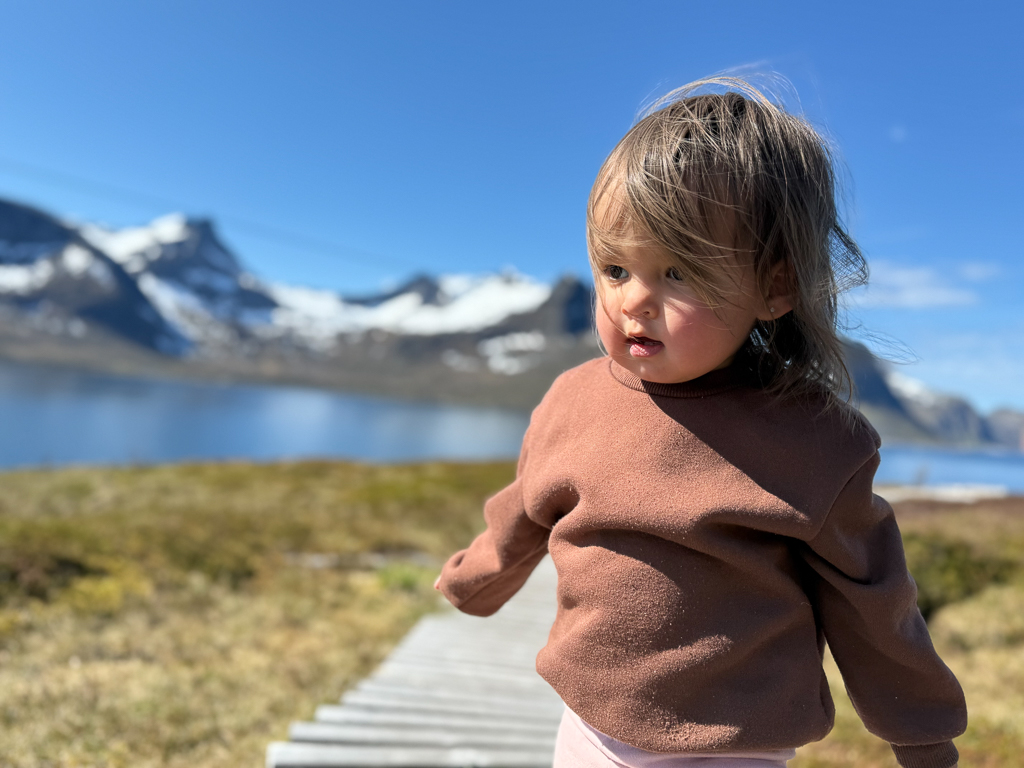
Lighthouse walk on Husoy island
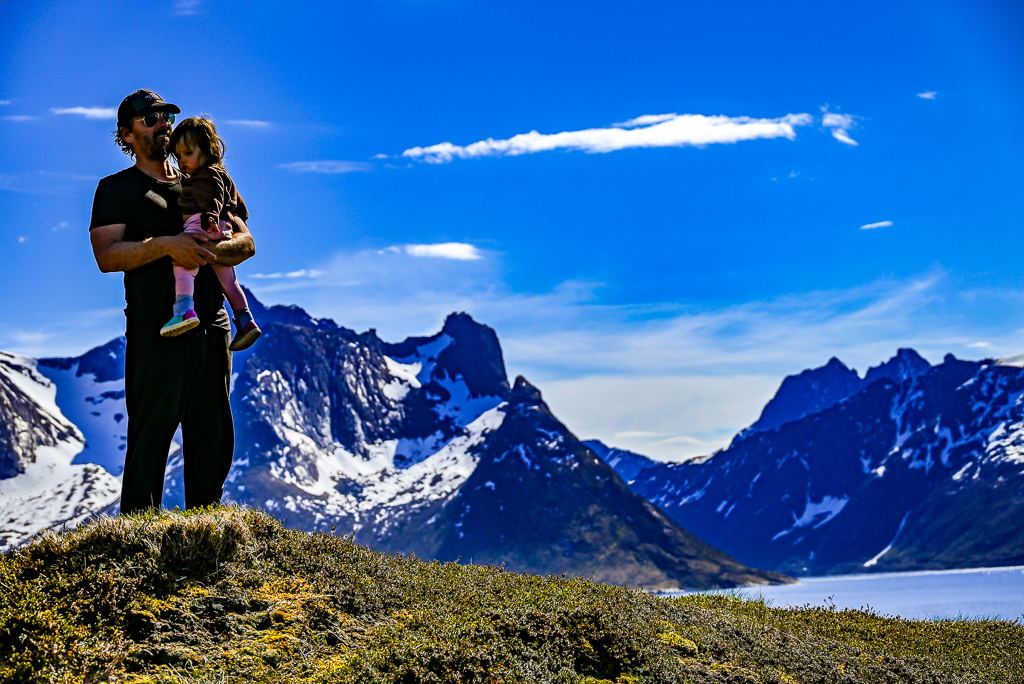
Lighthouse walk on Husoy island
Segla mountain from the west facing fjord
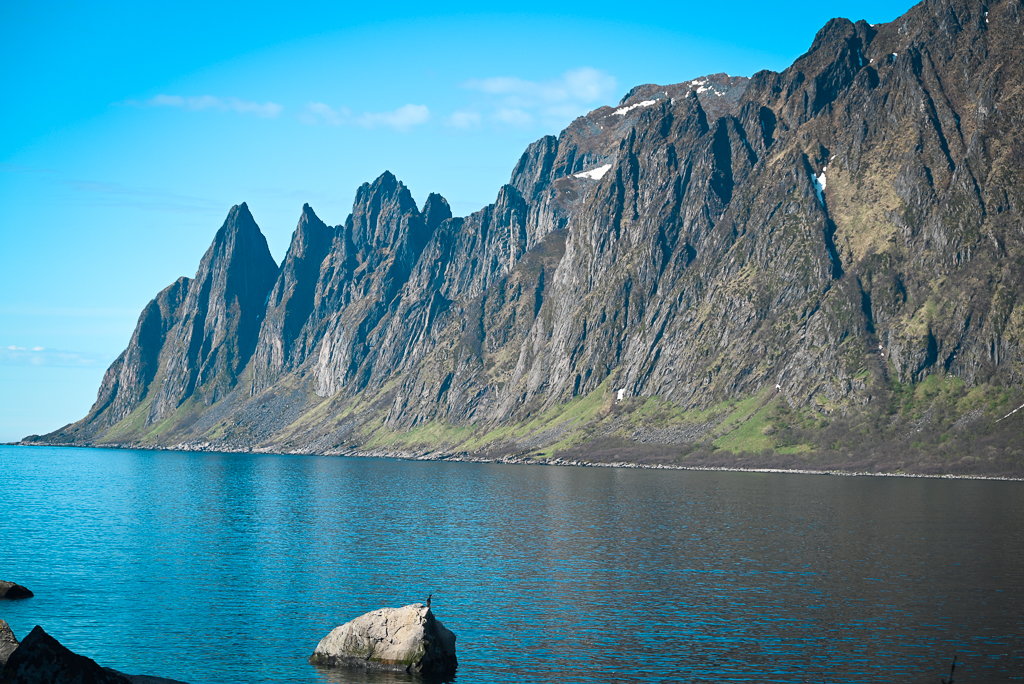
More Incredible Majestic Fjord Cliffs
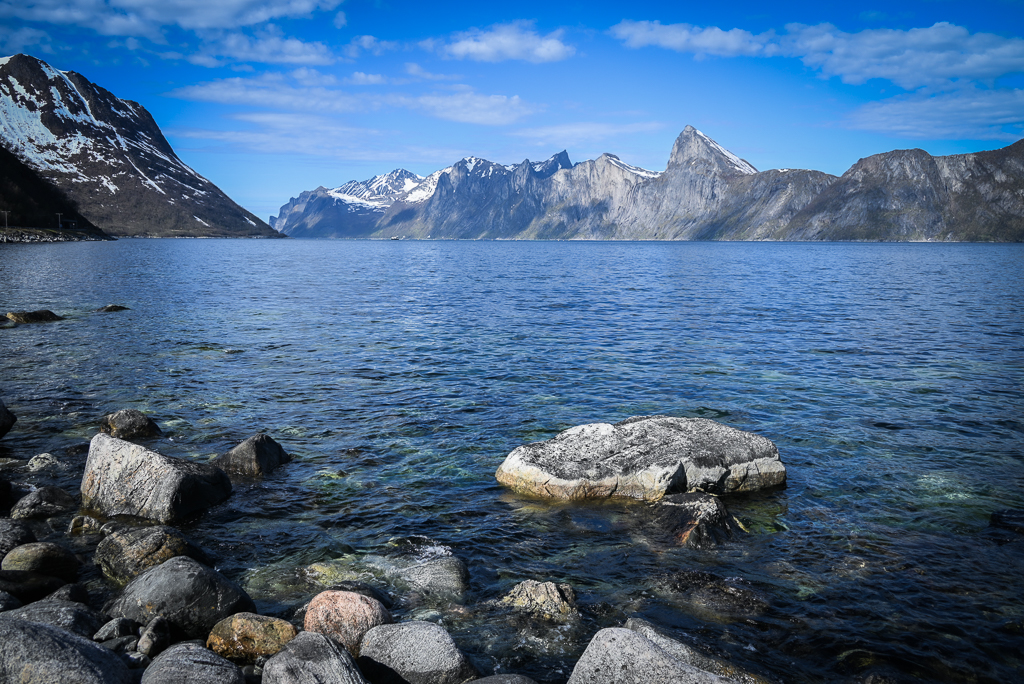
More Incredible Majestic Fjord Cliffs
Ersfjord Beach: Arctic Paradise in Disguise
Ersfjord Beach was, without question, one of our favorite places on the entire island. It’s hard to describe the feeling we had when we arrived—pure disbelief. We stood there, stunned, trying to process where we were.
Hundreds of miles north of the Arctic Circle, on the edge of the Arctic Ocean, and yet… we were standing on a white sand beach, staring out at turquoise water that looked like it belonged in the Caribbean.
Surreal and Sublime
The sun was shining. The sky was clear. It was warm. Not just “for the Arctic” warm, but actually warm. And behind the beach, towering above the fjord, were jagged snow-capped mountains, rising like a wall of stone and shadow behind that glowing sea. The contrast—beach, water, and mountains all at once—was almost too beautiful to believe.
We were all swept up in it, especially Indie, who immediately kicked off her shoes and ran barefoot down the beach, squealing with joy. Watching her tiny footprints stretch across that arctic sand felt like a dream within a dream.
A Quick (and Cold) Swim
Of course, the water was freezing. This was the Arctic, after all. But we couldn’t resist. We laughed, dared each other, and then one by one, we plunged in—just for a moment. The cold hit like electricity, but the joy that followed was worth it.
We were in heaven.
It was one of those rare places that doesn’t just live up to the photos—it exceeds them. A place so wild and unexpected that it makes you forget everything else. It reminded me that sometimes, when you travel to the edges of the map, you find the edges of yourself too—and they’re often barefoot, laughing, and ankle-deep in freezing water.
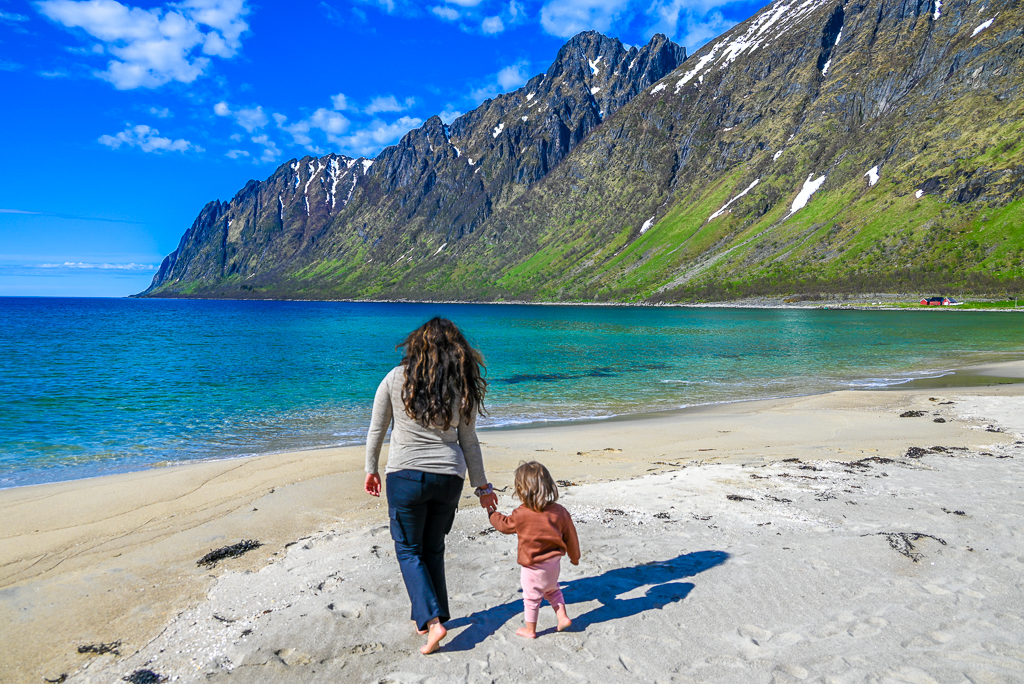
Ersfjord Beach
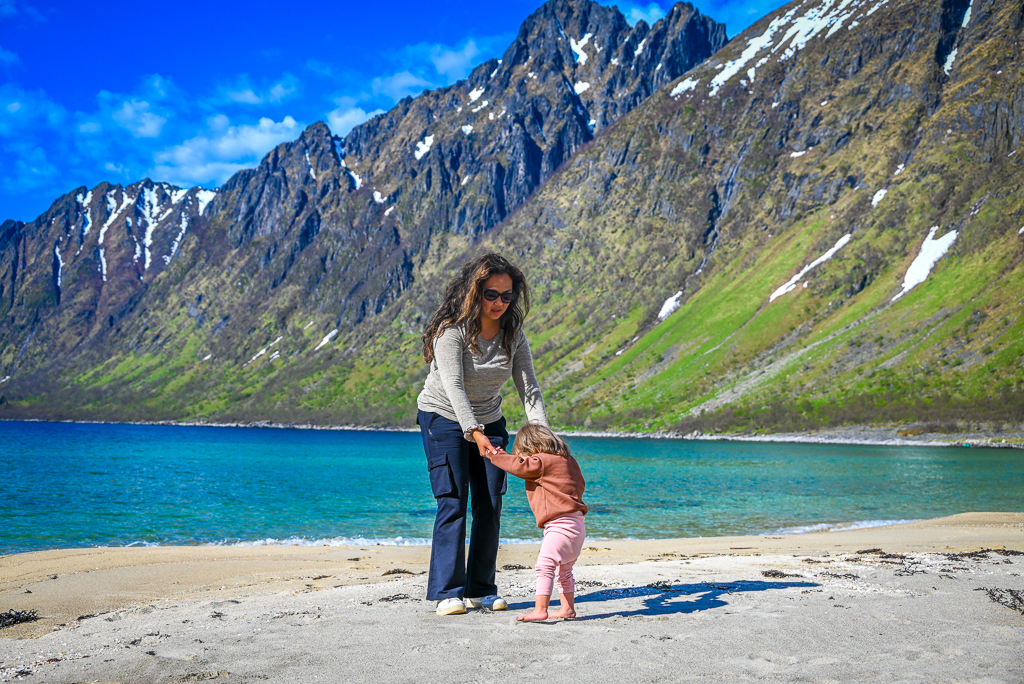
Paula and Indie at Ersfjord Beach
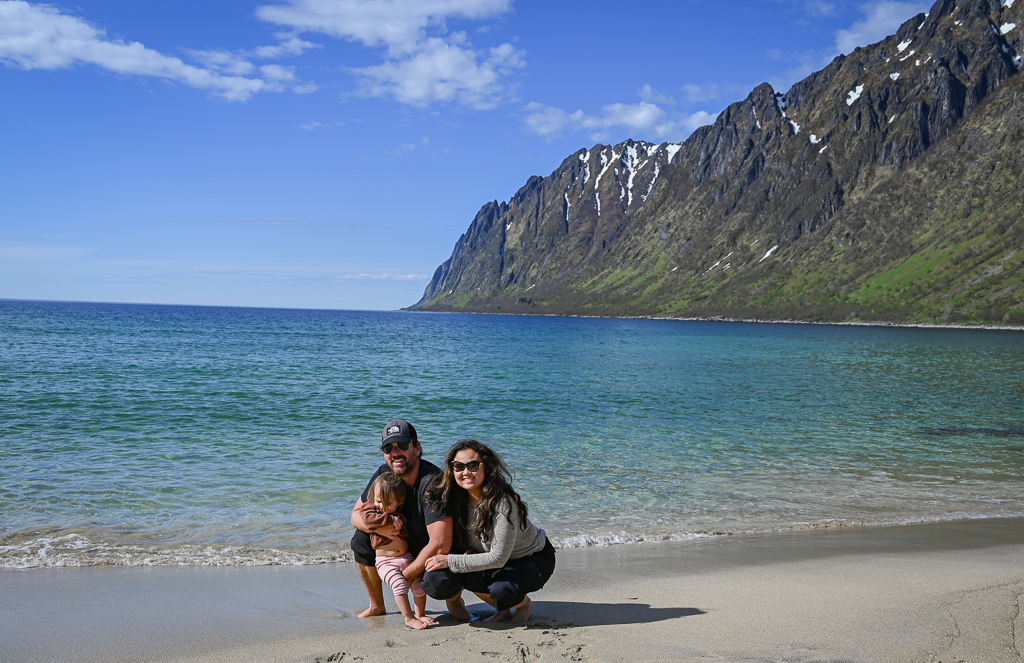
Family photo at Ersfjord Beach
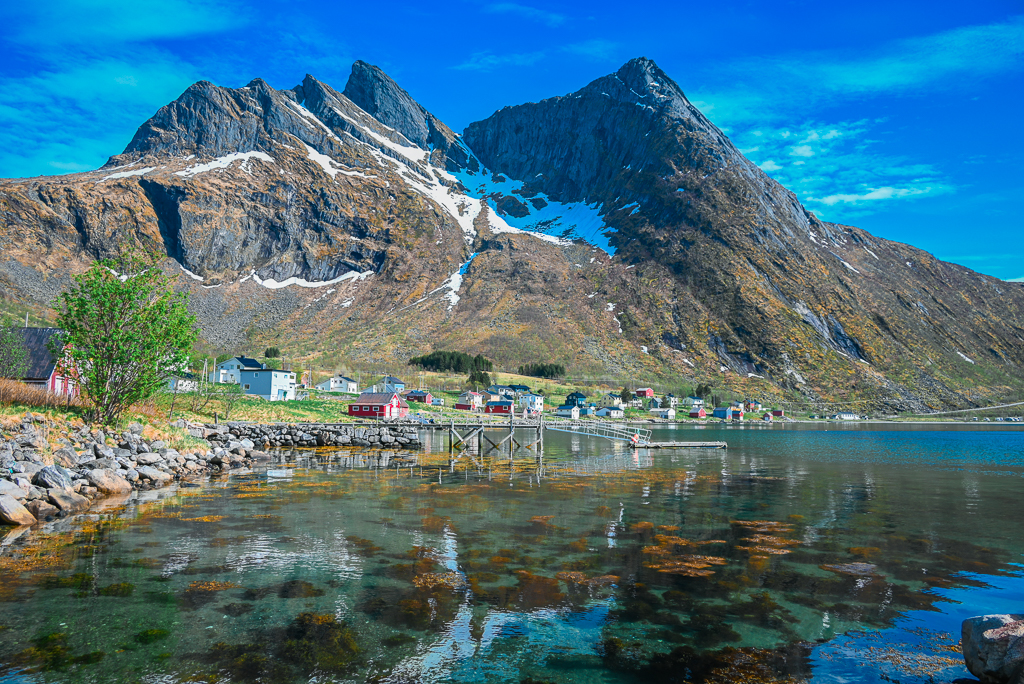
Idyllic fishing village
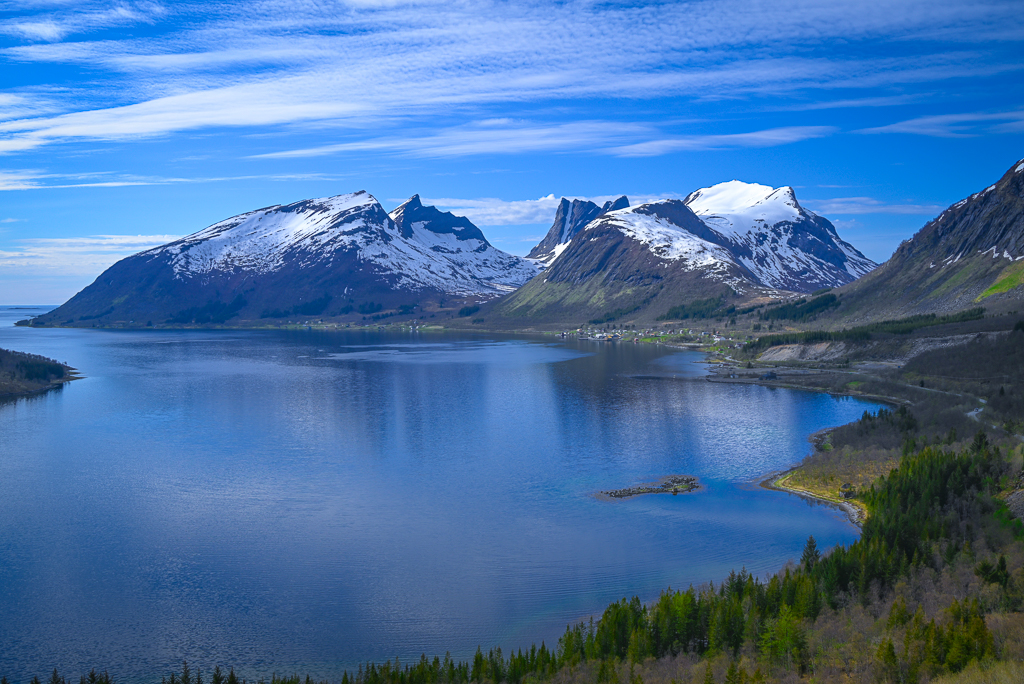
View of the fjords from a mountain pass right before entering a long tunnel
Nazi Naval bases and Quiet Churches: A Final Day on Senja
On our last day on Senja, I found myself doing something I often do while traveling through Europe: searching for nearby abandoned WWII ruins. As a lifelong WWII history buff, there’s something about the faded remnants of old war infrastructure—especially the ones that haven’t been sanitized for tourism—that always pulls me in.
The night before, a quick search turned up a photo of a ruined Nazi naval base, built during the German occupation of Norway. It looked like it was about 30 miles north of where we were staying. It wasn’t listed on any official maps or tourism sites, just a single image tucked away in a forum—but that was enough for me. We decided to go explore.
A Church by the Water
On the way, we made an unplanned stop at what turned out to be one of the most moving places of the entire trip—a small white wooden church perched peacefully beside the water. Behind it was a quaint little graveyard, its headstones leaning gently in the moss and lichen, many dating back hundreds of years.
There was no one else there. Just the wind, the sound of waves lapping nearby, and the long shadows of history etched into every grave.
Standing there, I tried to imagine life here centuries ago—how people lived, worshipped, and died in this far northern corner of the world. It’s hard to picture so many once living in this remote landscape, especially now that many of these towns feel nearly deserted. Most of the people we saw driving through were elderly—their children and grandchildren likely having moved south to the cities in search of jobs and excitement. What’s left behind are these quiet villages, slowly growing quieter.
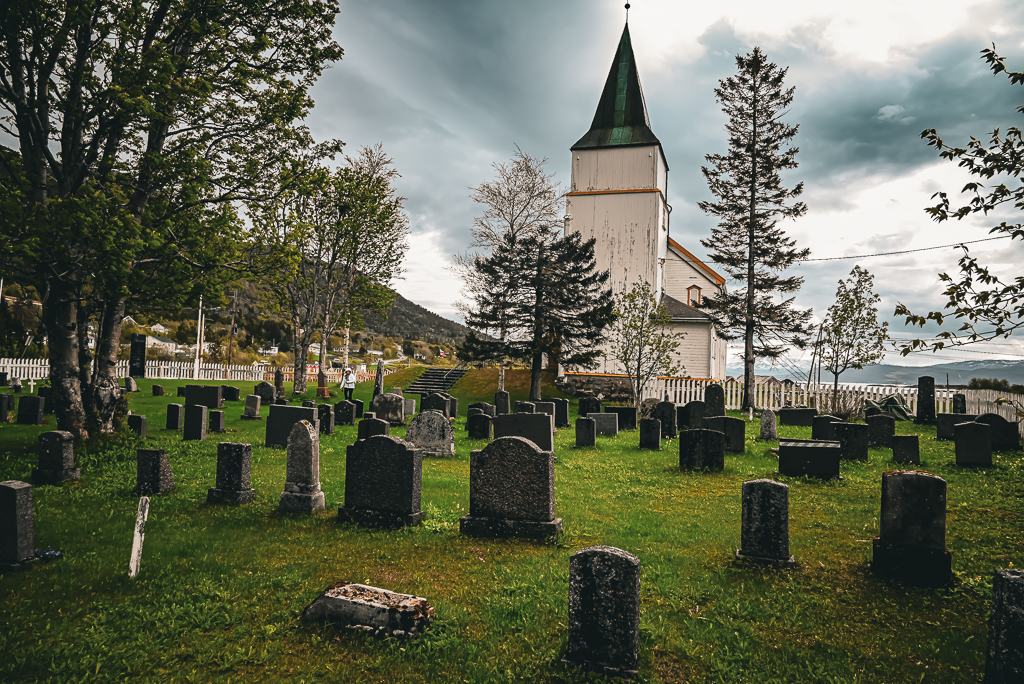
Stonglandet Old church graveyard
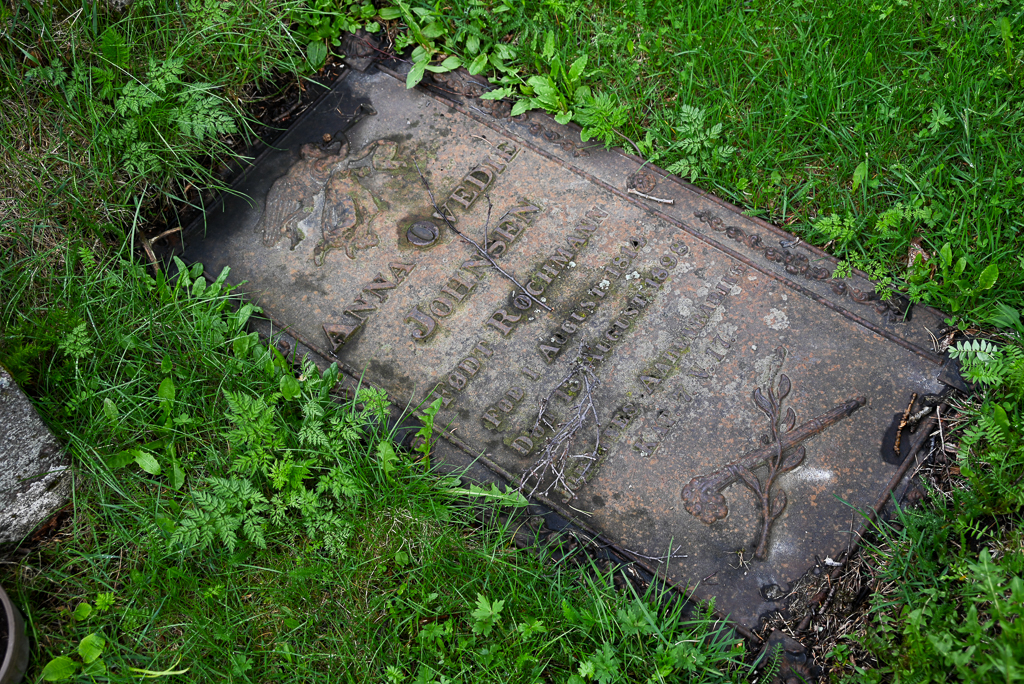
One of the old graves
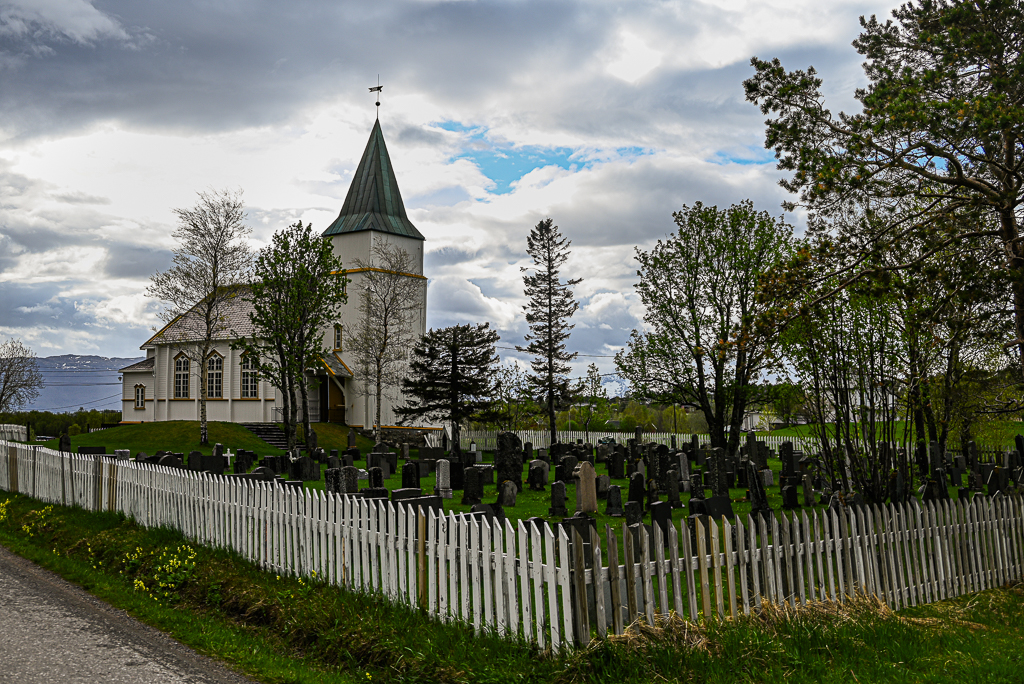
Stonglandet Old church graveyard
The Unexpected Finds: Skrolsvik Nazi Fort and WWII Echoes
The best part of travel—at least for me—is the unexpected surprises. The moments that aren’t planned or polished, the places that don’t show up on the first five pages of a Google search. That’s how we ended up at Skrolsvik Fort, a decaying Nazi-era World War II naval battery tucked away on the southwestern edge of Senja.
I had stumbled across a vague reference to it the night before, while casually searching for abandoned WWII sites nearby—a habit I’ve developed while traveling in Europe as a history buff with a soft spot for forgotten war ruins. Sure enough, there was a grainy photo and a set of rough coordinates. The next morning, we set off.
Family Secrets and War’s Lingering Shadow
When we returned to our fishing cabin later that evening, I shared what we had found with the Norwegian woman who owned the cabin. Her husband, a local from the island, had grown up near the fort. She hesitated for a moment and then told me a family story—one that still seemed to carry a trace of discomfort.
Her husband’s great-aunt, she explained, had an affair with one of the German soldiers stationed at the base during the war. The relationship caused such a scandal in the family that the woman was eventually forced to migrate to America, her name and memory tangled in shame and silence. It was a stark reminder that war’s impact doesn’t end with peace treaties—it seeps into families, into memory, into identity.
A Fortress Lost to Time (and Reindeer)
Finding the fort wasn’t easy. It wasn’t well signposted, and even once we arrived, we weren’t entirely sure we were in the right place. A single weather-beaten information sign stood near the entrance, but it said nothing about Nazis—just a vague reference to a “coastal battery” and some historical dates.
From what I could gather, the base was originally built by the Nazis, then taken over by the Norwegian military after the war, and used for several decades before being abandoned entirely in the 1970s. Now, it belongs to the elements—and the reindeer, who graze freely across the windswept fields and moss-covered bunkers.
There are warning signs about unexploded ordnance, a sobering reminder that not everything buried has been forgotten. But for those who seek out hidden history, Skrolsvik Fort is an explorer’s dream.
Into the Depths
The complex is sprawling, with decaying barracks, overgrown storage buildings, and massive artillery guns still mounted in rusting silence on hills scattered across the terrain. The whole scene unfolds with a backdrop of snowcapped peaks and the vast, icy calm of the Arctic Ocean.
But the best part? That came when Paula and I stumbled across a tunnel that led to a dark staircase descending multiple levels underground. We had left Indie in the care of Paula’s mom and decided to do a bit of exploring—cautiously, not wanting to push too far into a structure that felt one good tremor away from collapse.
The air was damp and stale. The walls were still covered in brightly colored paint, which we later learned was designed to help boost morale and combat depression during the long, dark winters. But now, it was peeling and toxic, a patchwork of fading color and rot. We made sure not to touch anything.
Deeper underground, the tunnels branched out in every direction, leading to what must have been the bunkers, control rooms, and ammunition depots. It was easy to imagine how soldiers could have spent months down here, buried beneath tons of snow and war.
There was no one else around. No tour guide. No rope barriers. Just us, the quiet hum of wind from above, and the ghost of history tucked into every corner.
Forgotten but Not Gone
Skrolsvik Fort isn’t a monument. It’s not curated. It’s raw, rusted, and real—a relic of an occupation most Norwegians would rather forget. And maybe that’s why it was so powerful. It felt like discovering a piece of the past that hadn’t been rewritten or reframed, just left there—as it was.
For Paula and me, it was one of the most fascinating places we visited on the entire trip. The fact that we had it all to ourselves made it even better. No crowds. No signs. No souvenirs. Just story—and silence.
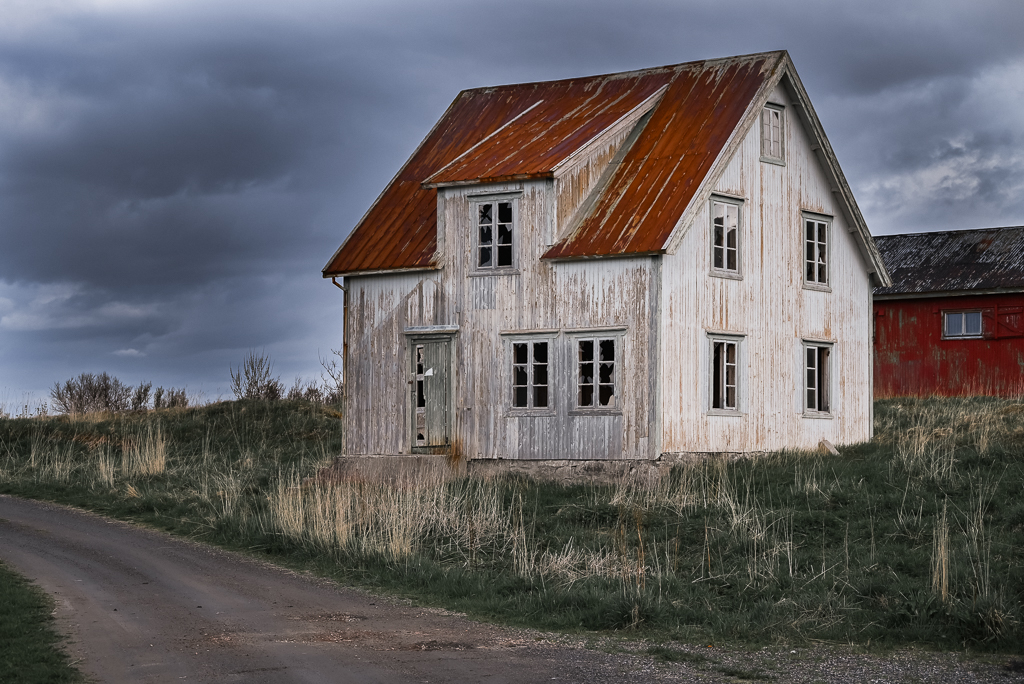
Abandoned wooden house at Skrolsvik Fort
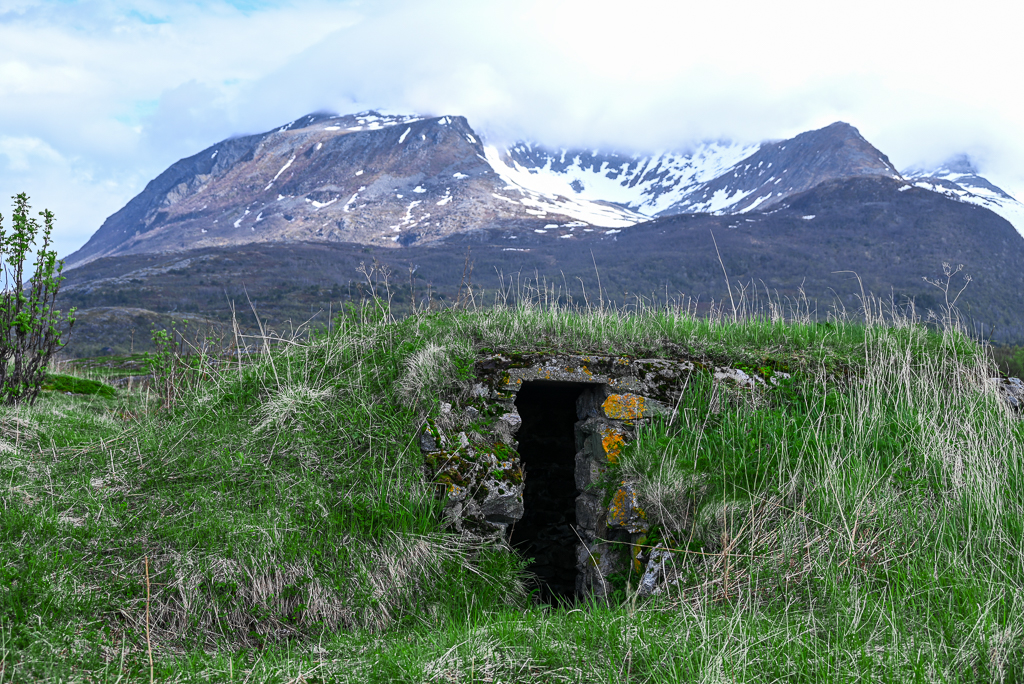
Bunker at Skrolsvik Fort
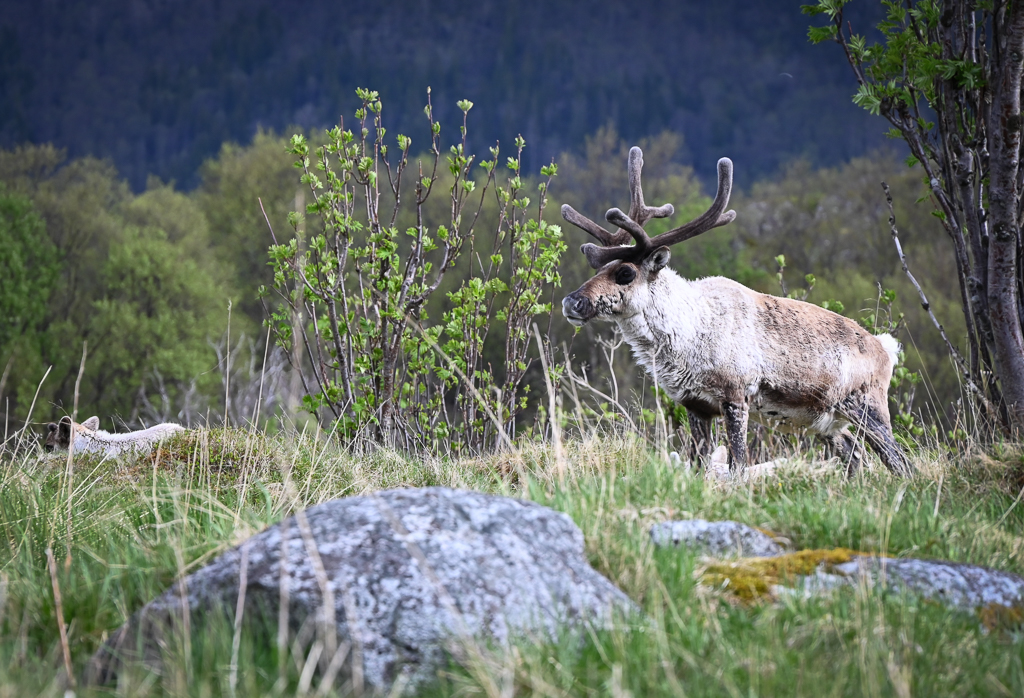
Reindeer grazing at Skrolsvik Fort
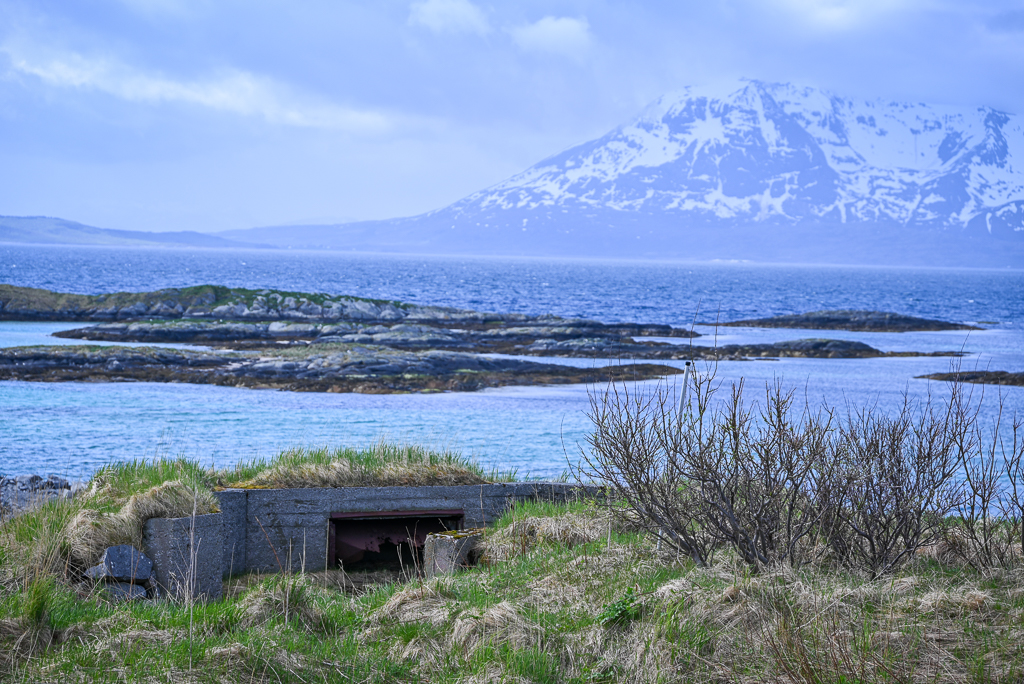
Skrolsvik Fort
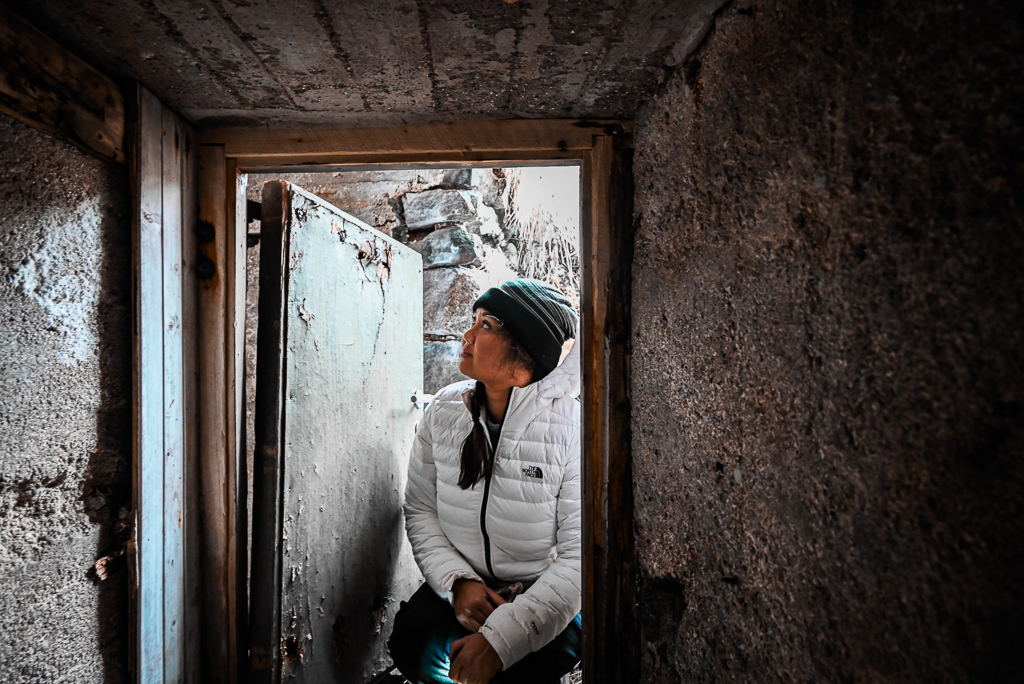
Paula exploring Skrolsvik Fort
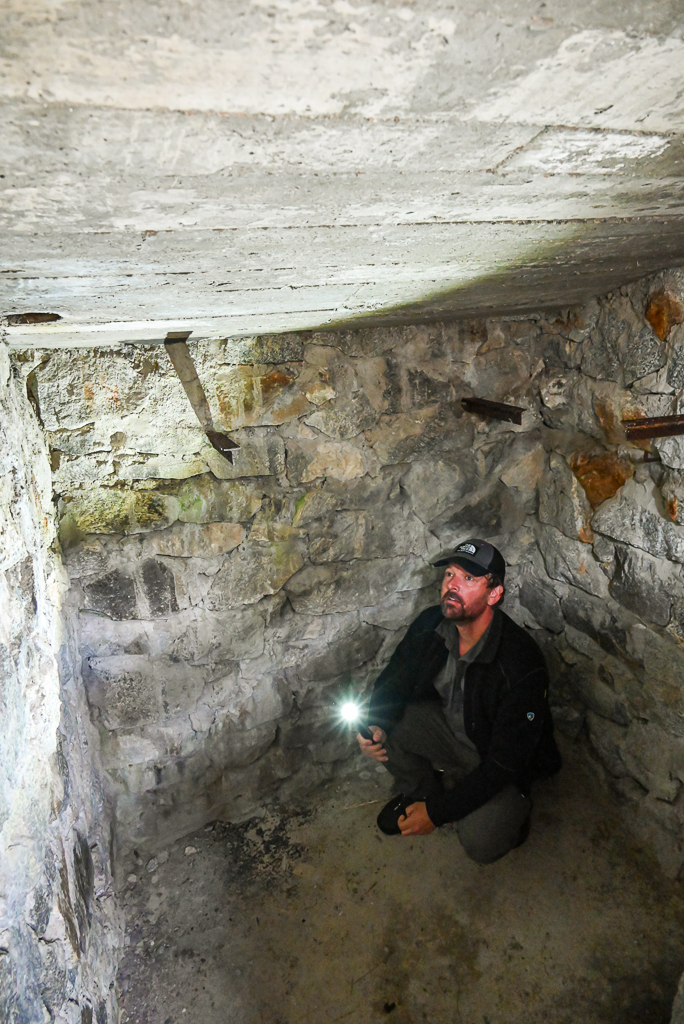
Me at Skrolsvik Fort
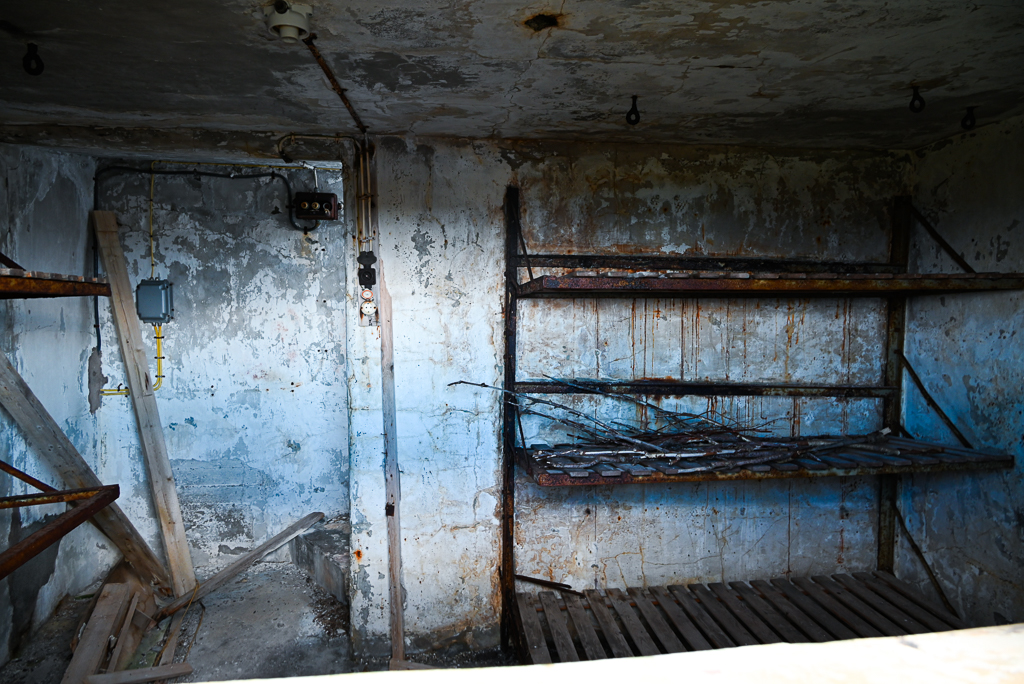
Sleeping Bunks
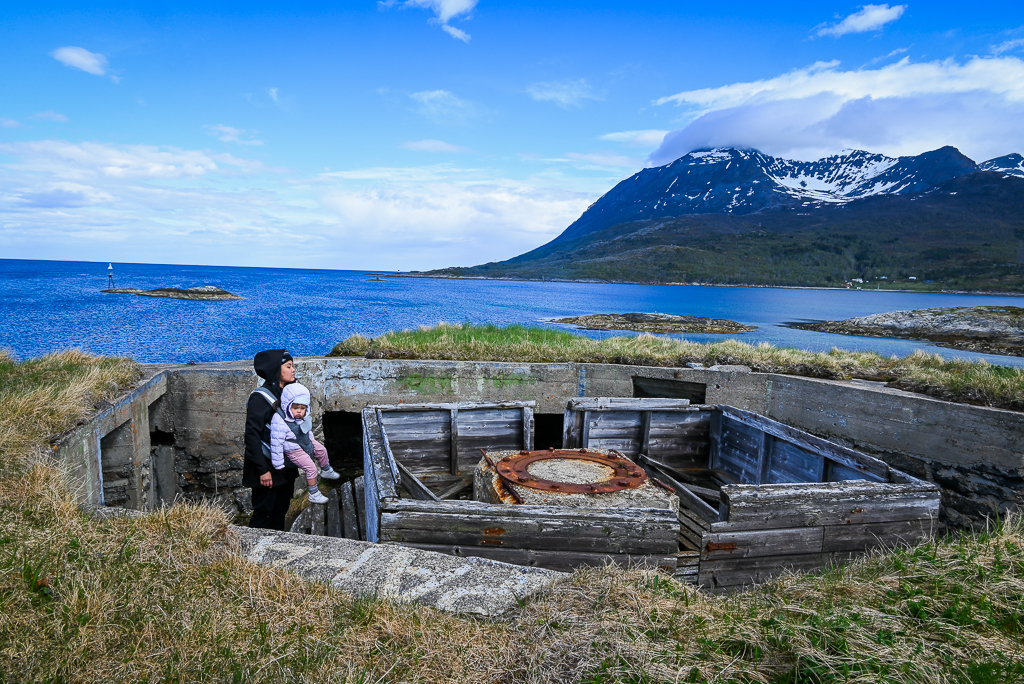
Paula and Indie at a bunker
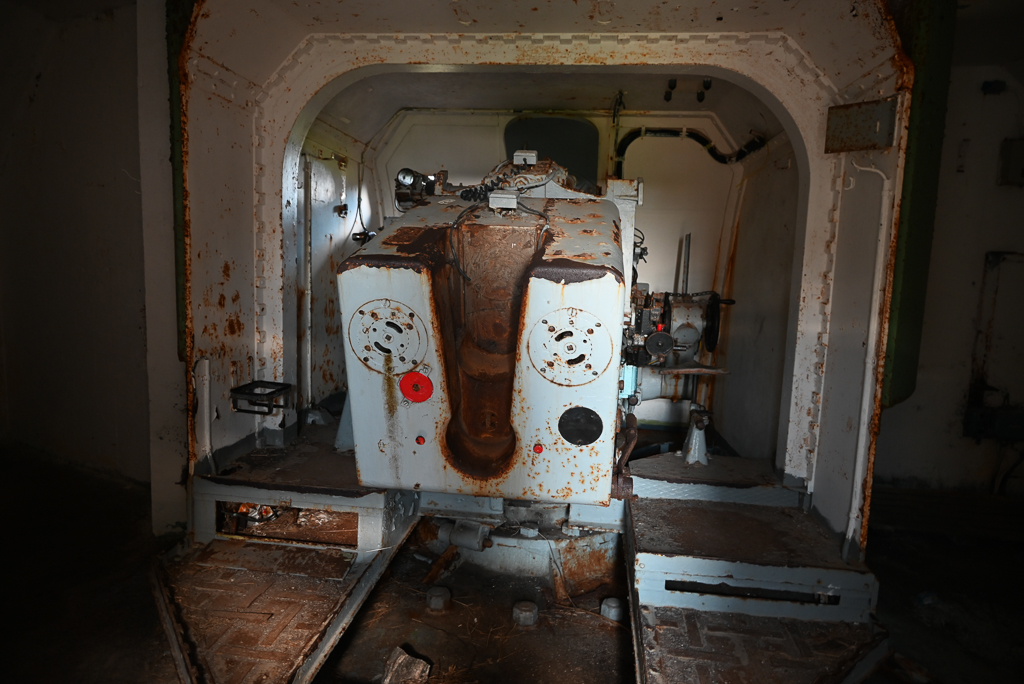
One of the big guns
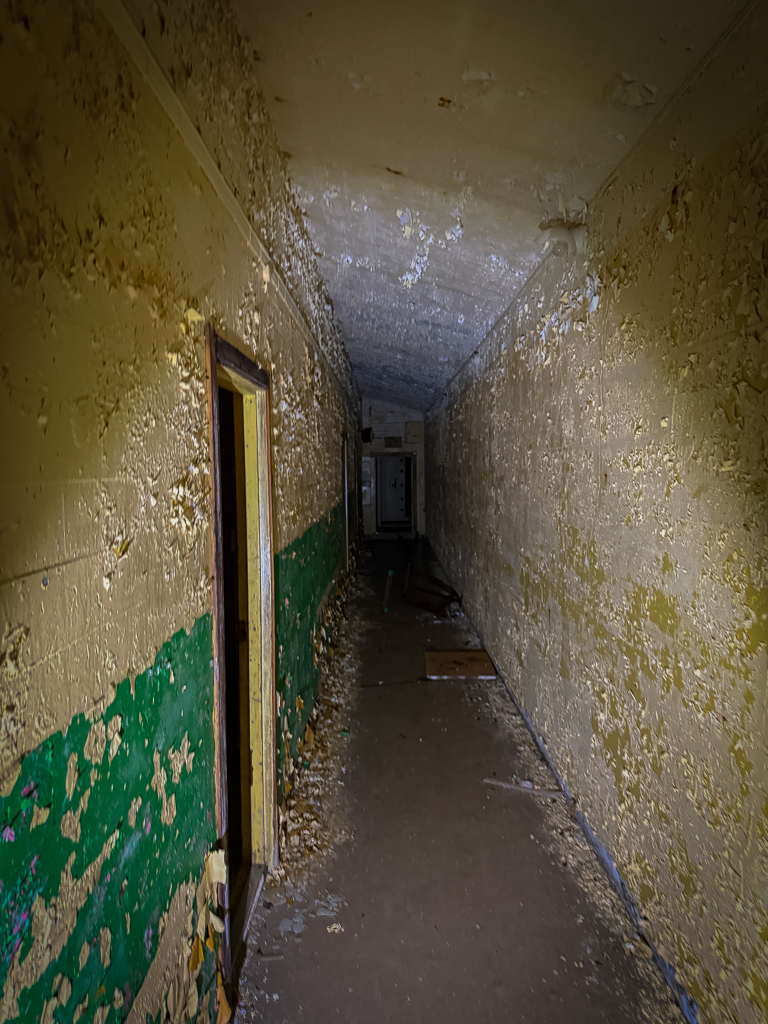
Tunnel
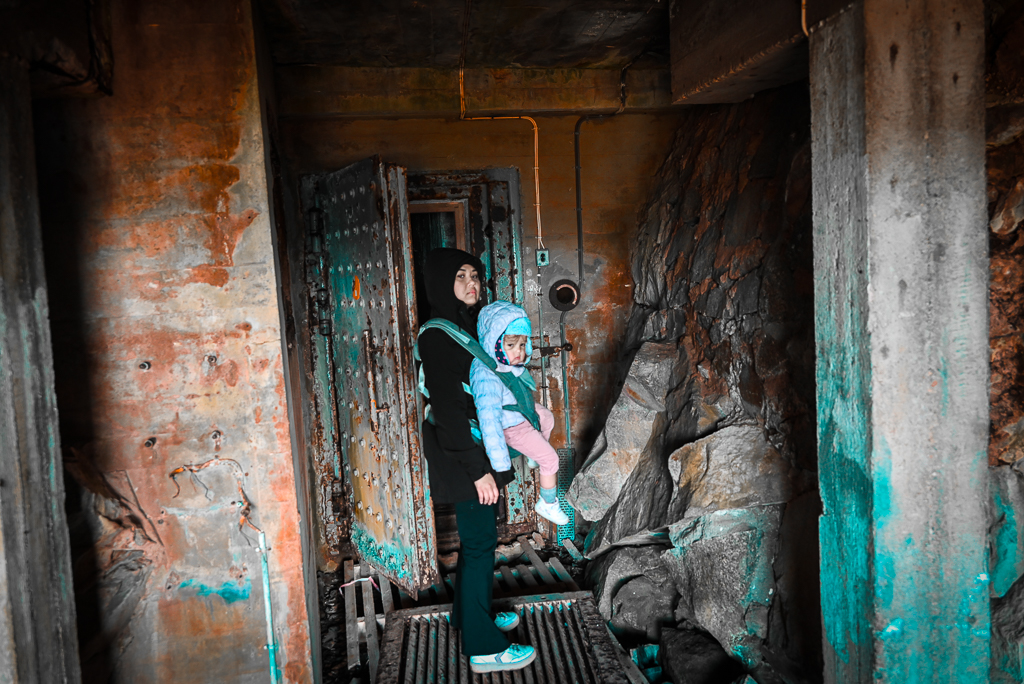
Paula and Indie at the entrance to the vast tunnel network
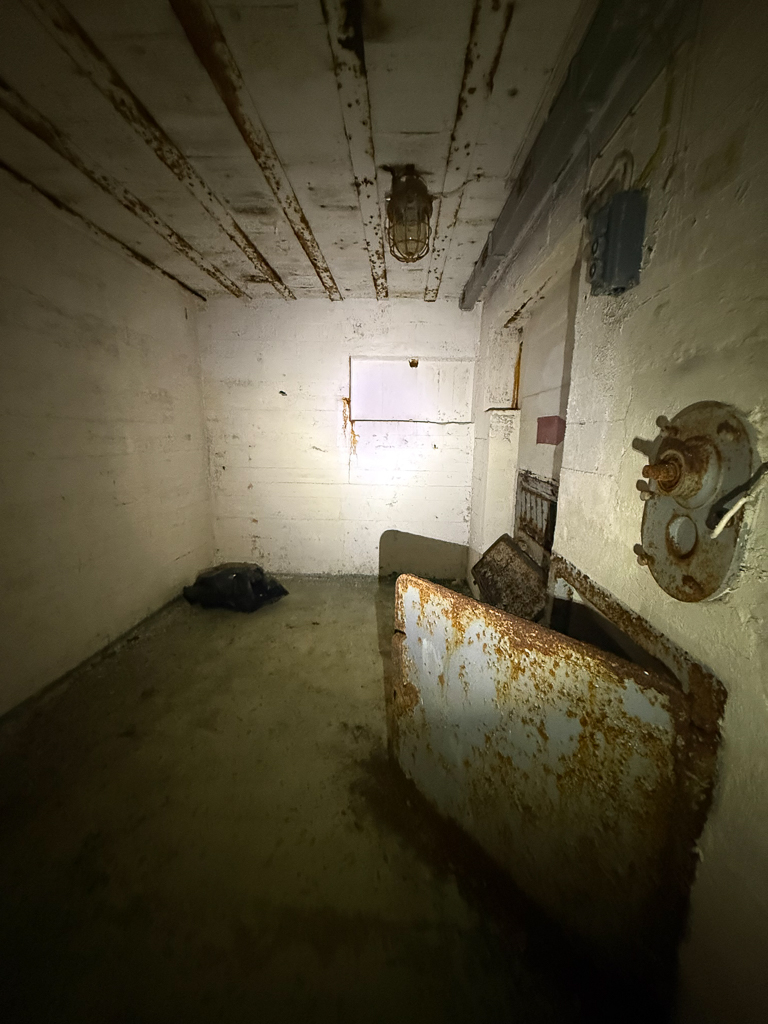
Underground room with a furnace of somekind
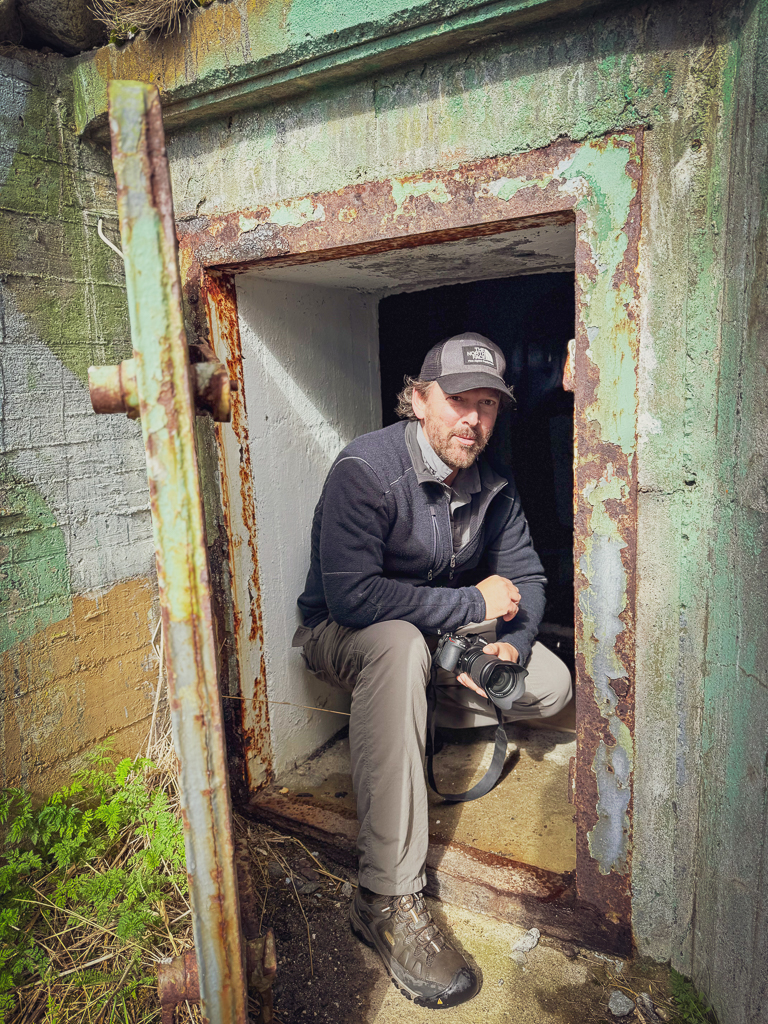
Me in my element exploring
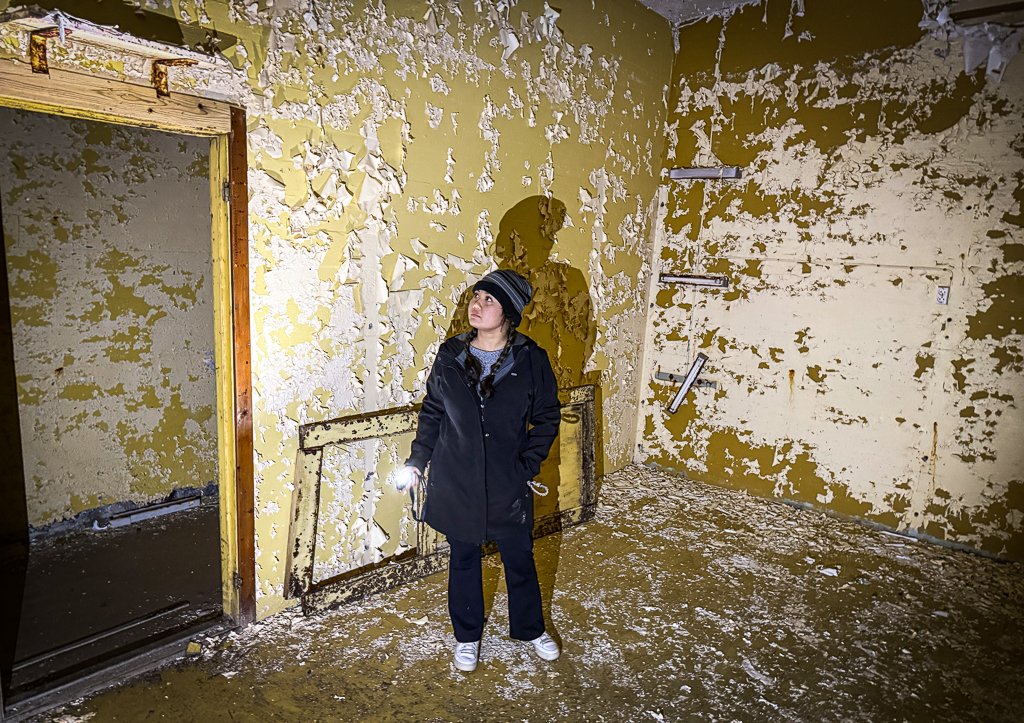
One of the underground rooms
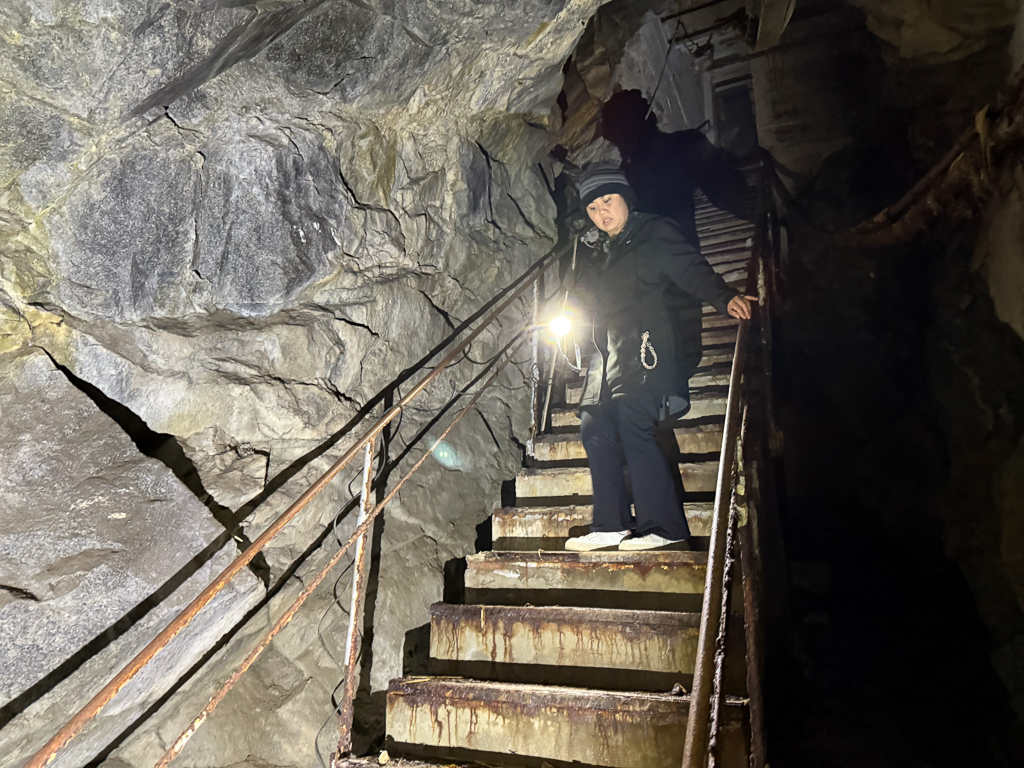
Down the rickety stairwell into the cave tunnels
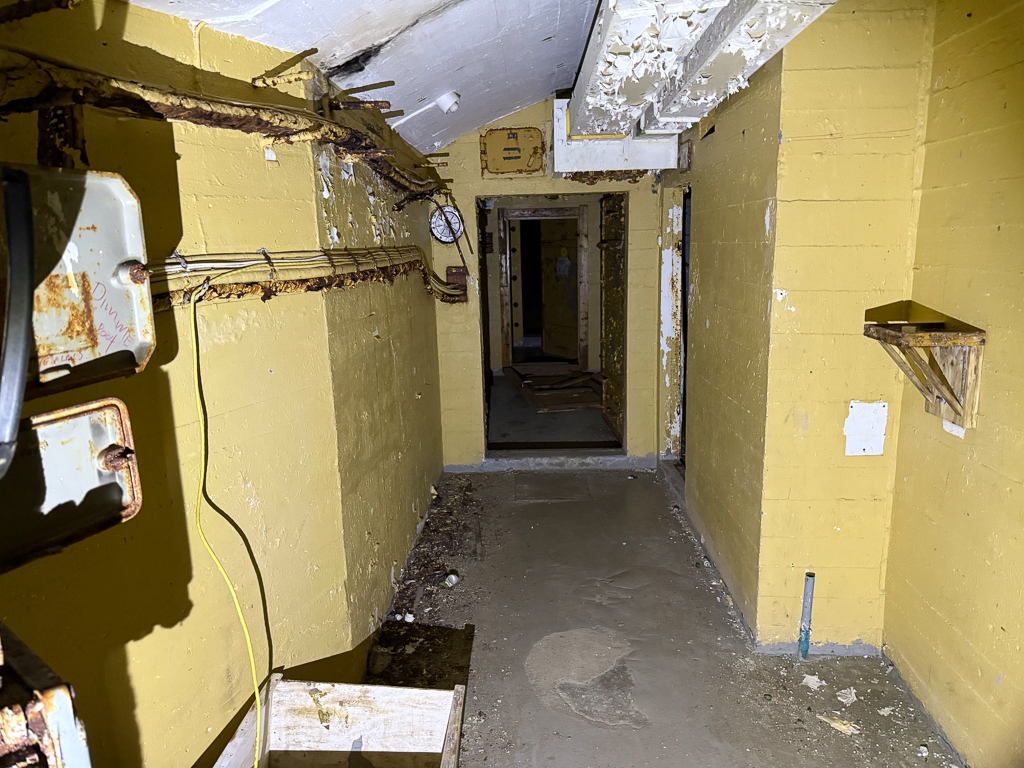
One of the hallways. The area is so remote that for an abandoned place, there is no grafitti
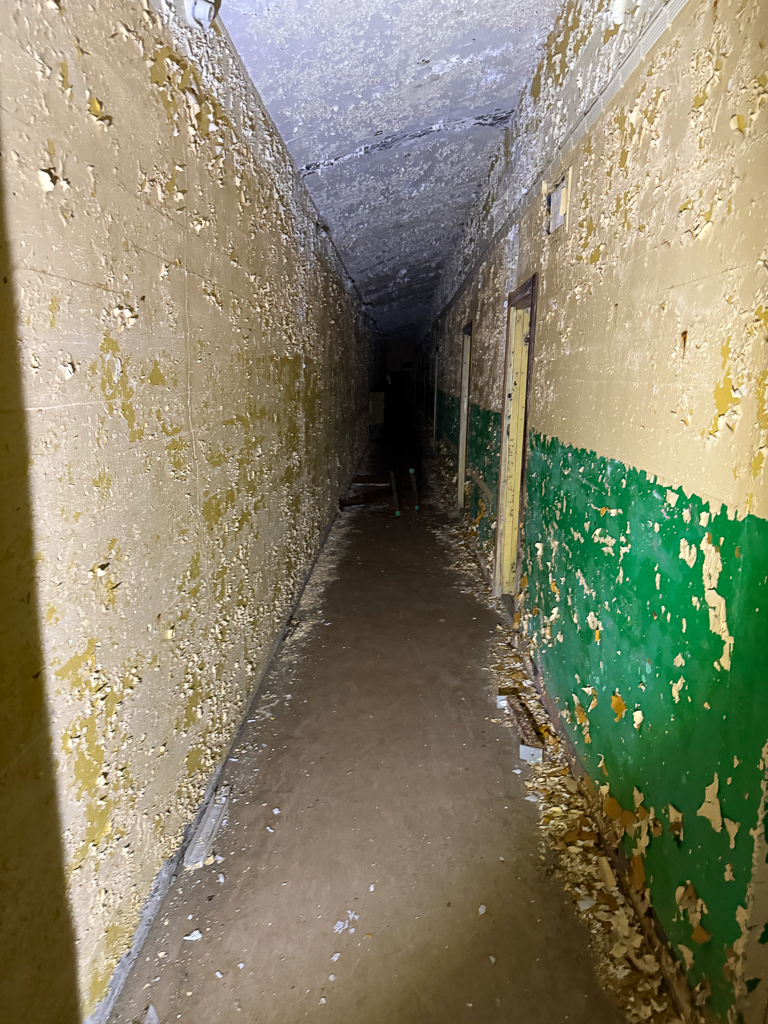
One of the hallways
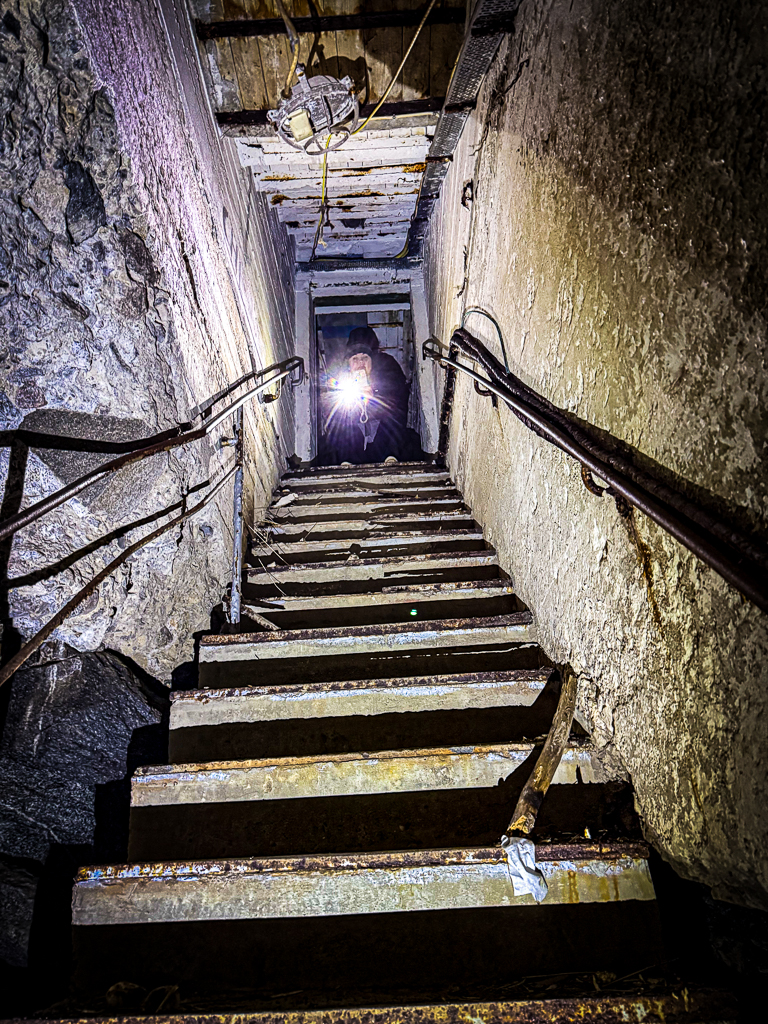
Stairwell into darkness
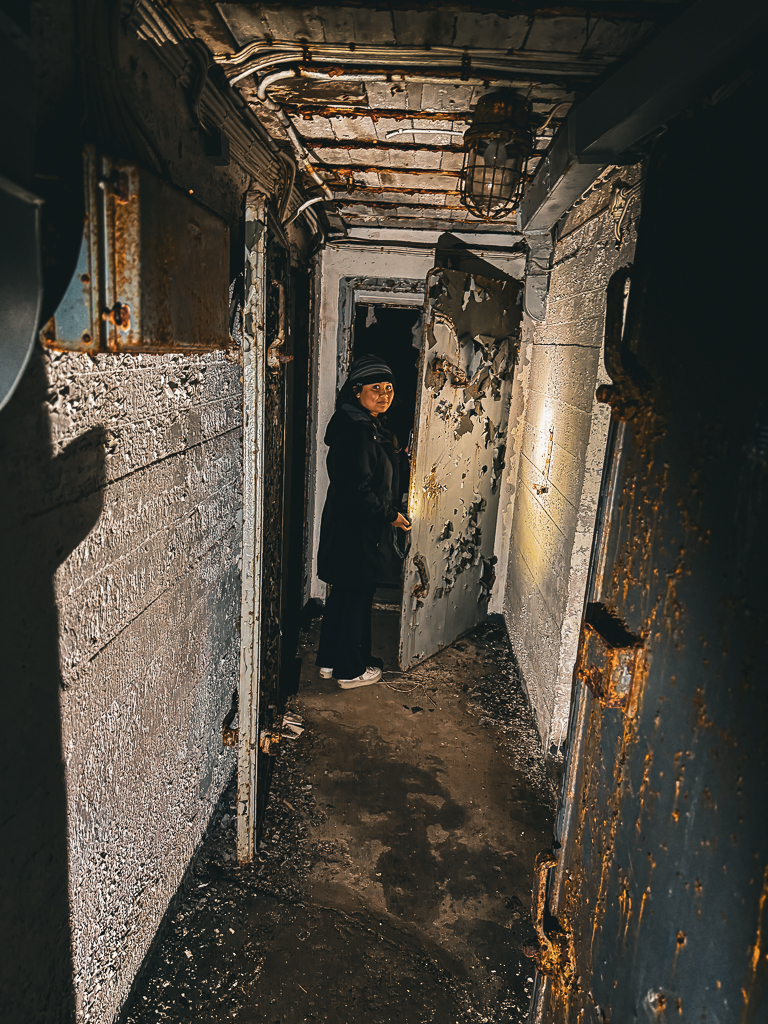
Paula walking down the tunnel cooridor
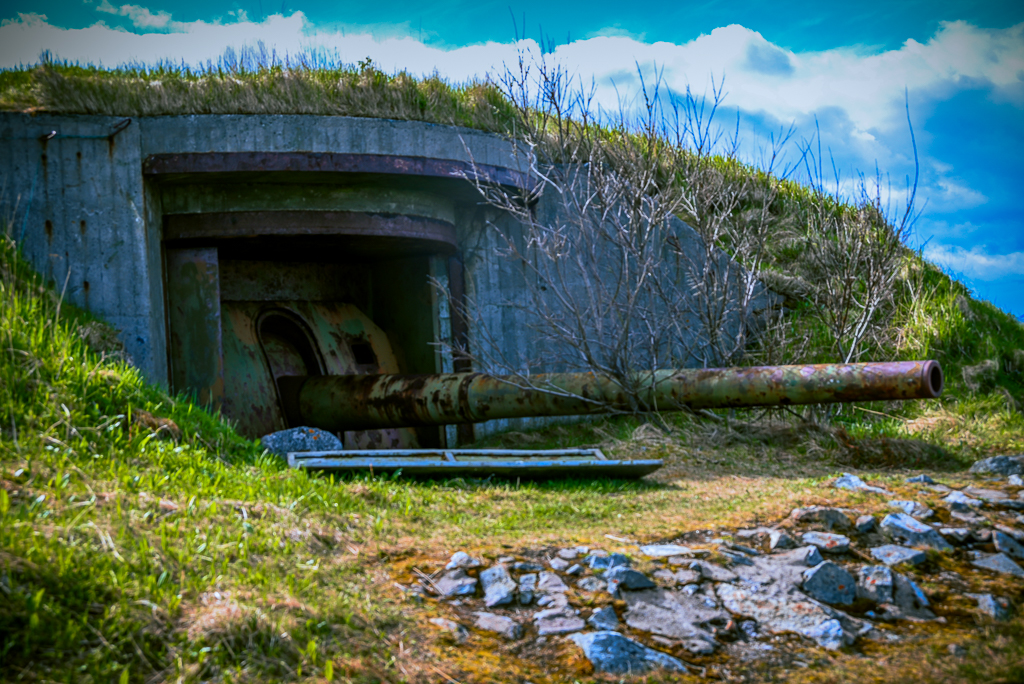
Big guns
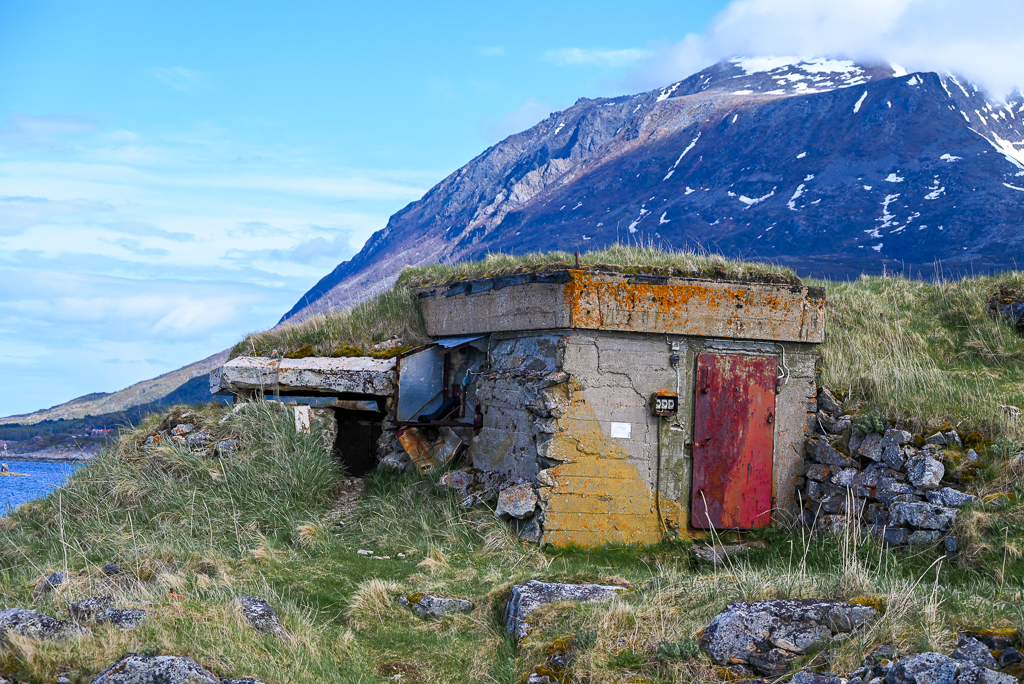
Bunker
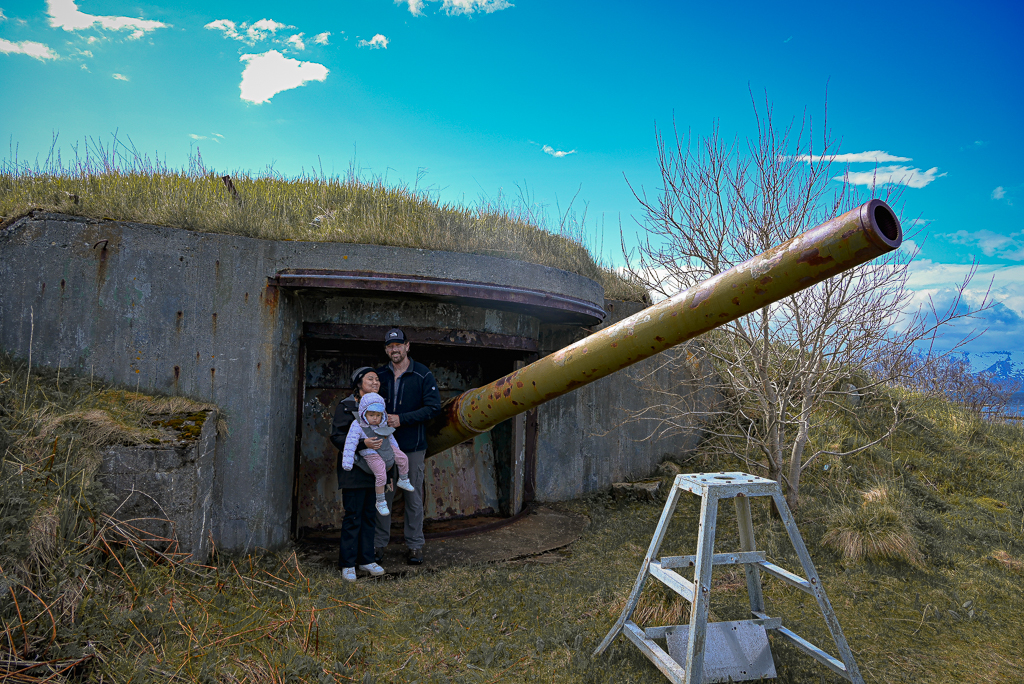
Paula,Indie and I in front of a Nazi Gun
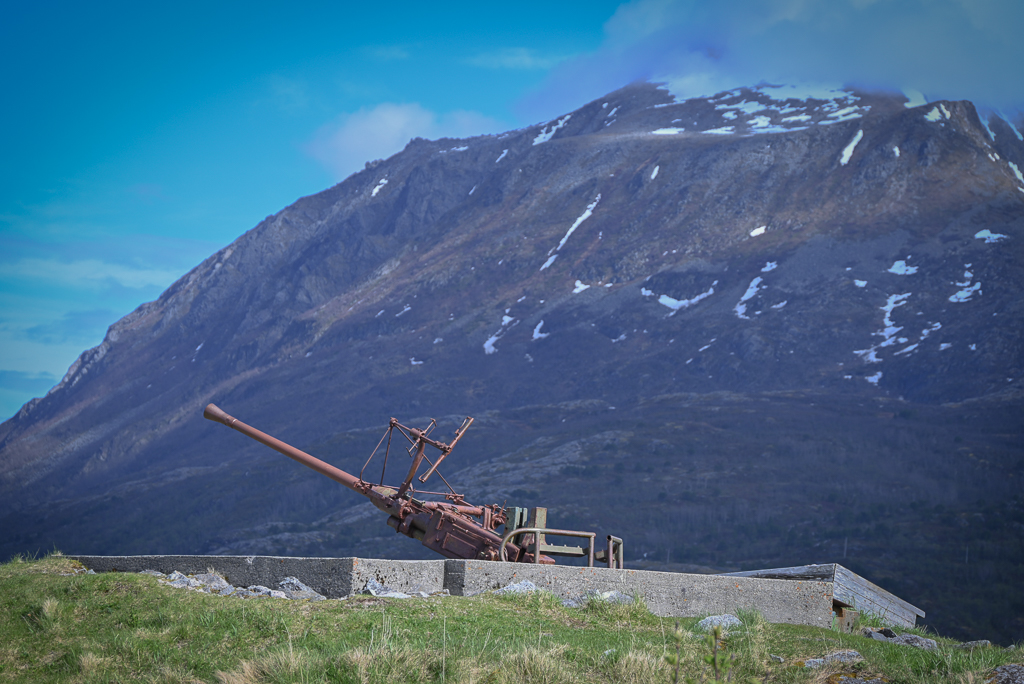
Big gun
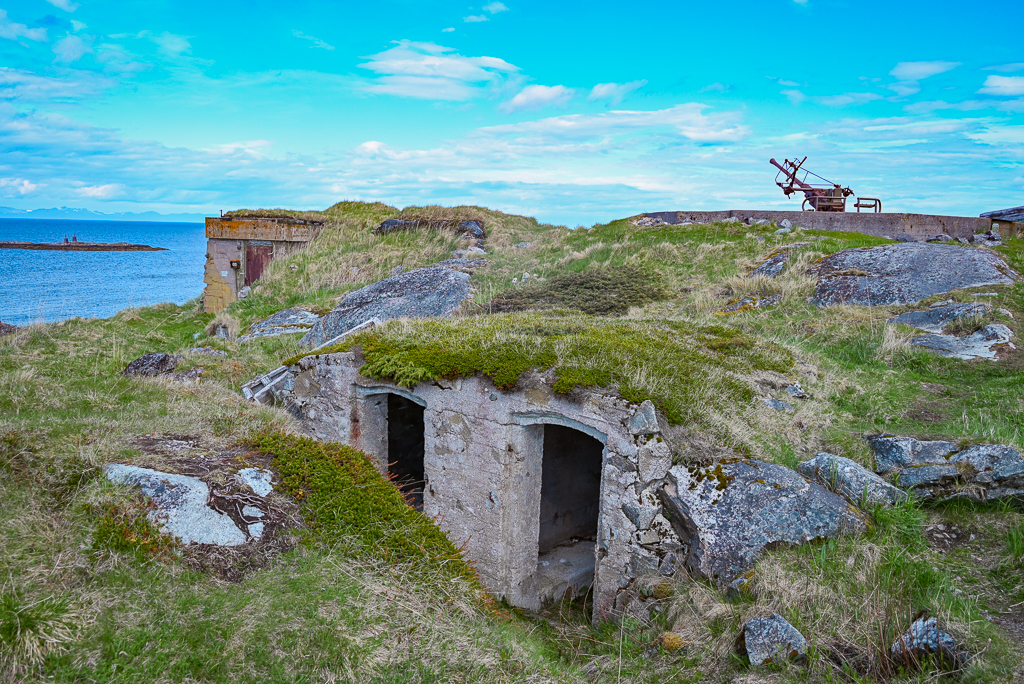
Bunker complex
One Last Day in the Land of Light
The weather had cleared, the clouds dissolved, and the sky turned into a crisp Arctic blue. With the sun high and endless, we decided to make the most of our final full day on Senja by exploring some of the most isolated fishing villages tucked deep within the fjords—places where the road simply ends, and the sea takes over.
The drive itself was a journey. Each turn revealed a new vista more stunning than the last—towering cliffs, glassy fjords, and small red cabins nestled along the shoreline. We passed through a few remote hamlets preparing for the upcoming Ascension holiday weekend, a quiet three-day stretch of family time in Norway. Along the roadside, we saw Norwegian families gathered around smoky barbecues, smoking fish, children running barefoot in the grass, and the scent of salt and fire in the air.
Somewhere between villages, we passed a freshwater lake—its surface still, surrounded by mountains that looked painted into the sky. We pulled over just to breathe it in. This was why we came. Every corner, every road, every small detour—nothing but sheer beauty.
A Final Toast to the North
As evening approached, we made our way back into town for one last dinner—a proper Norwegian send-off. I ordered the salmon, caught fresh and buttery-rich, and a glass of wine to toast the journey. The food was simple, pure, and deeply satisfying—the kind of meal that felt earned after days of exploring wild country.
We returned to our cabin one last time, lit by the soft golden haze of the midnight sun. Indie fell asleep quickly, worn out by so many days of wonder. We stayed up a little longer, looking out the window, letting the stillness sink in.
Tomorrow, we’d head back—through Tromsø, then onward through Sweden, and eventually home. But for now, we had one last night of peace, tucked into this quiet corner of the Arctic, the sea and mountains standing watch outside our window.
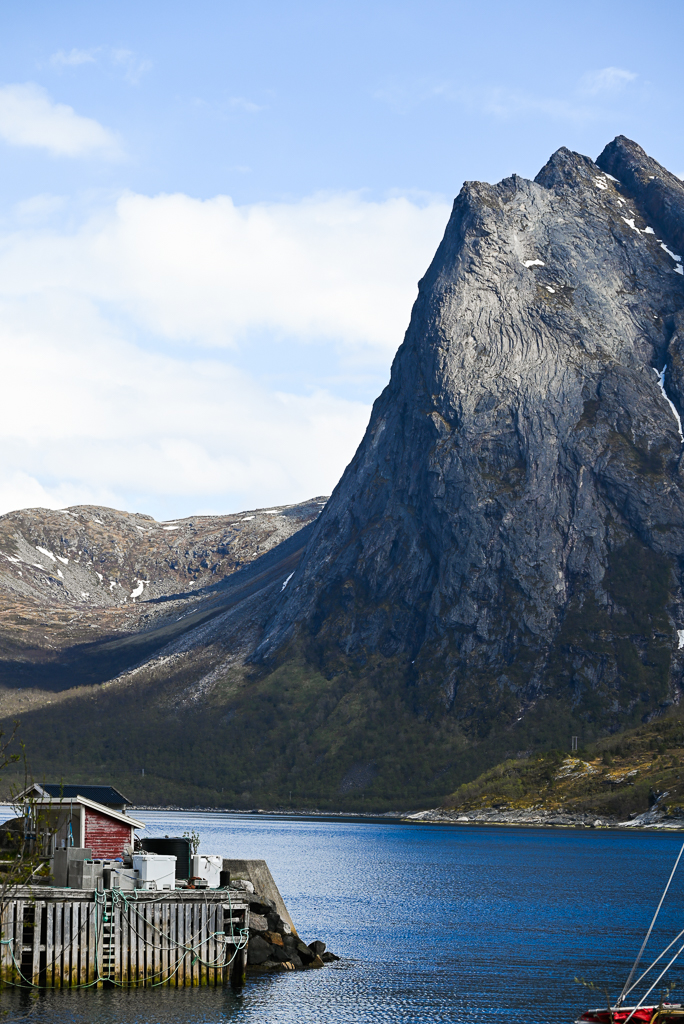
Rodsand Village
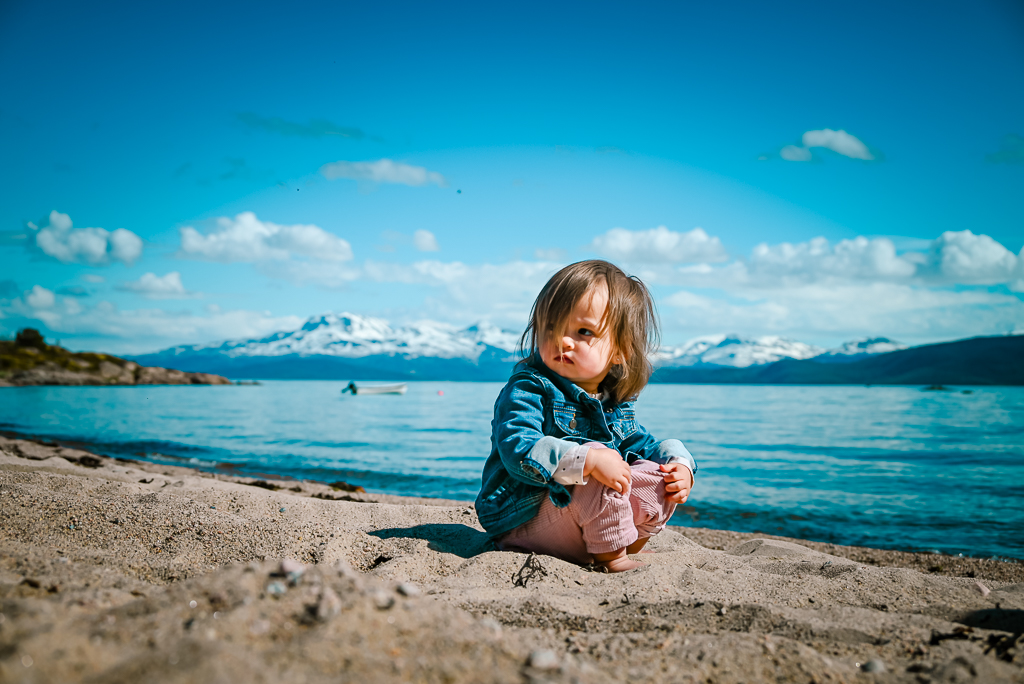
Indie playing on the beach
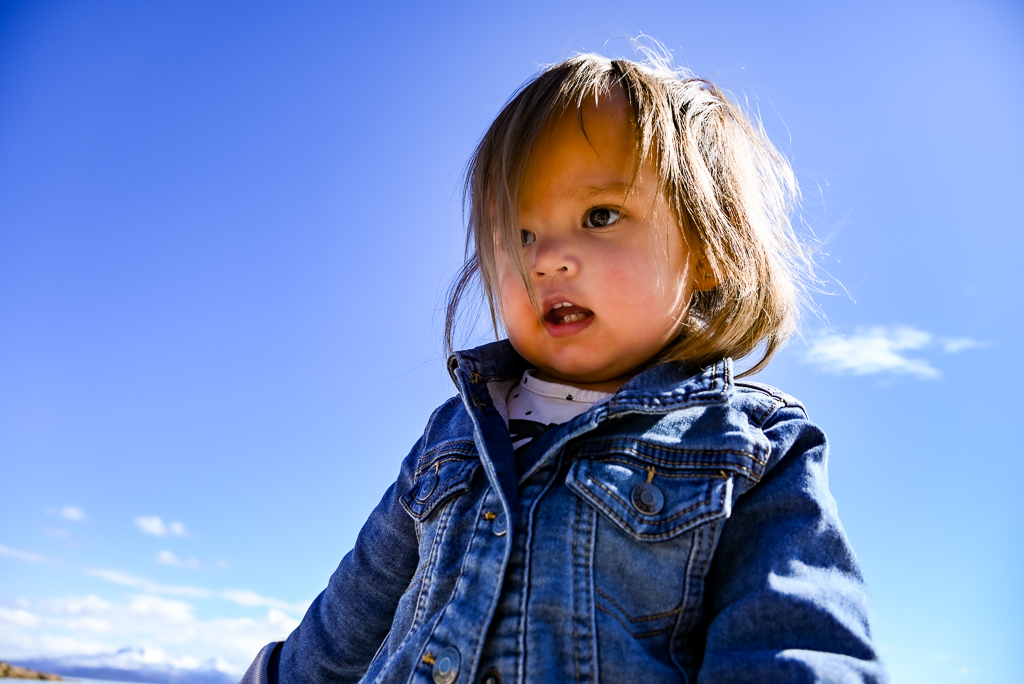
Indie playing on the beach
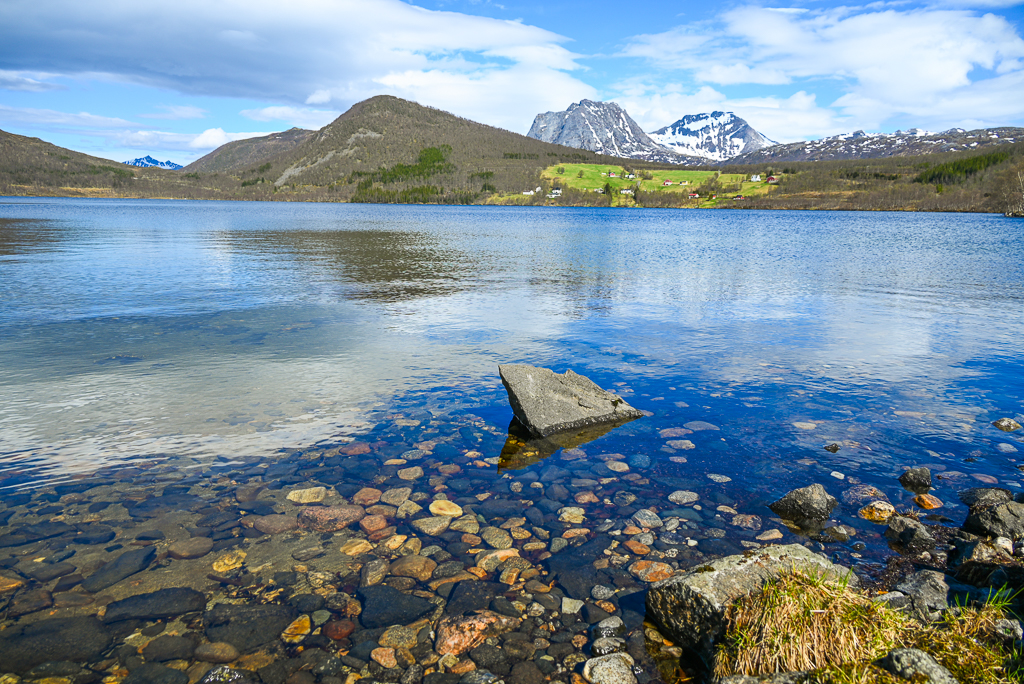
Olaheimvatnet Lake
Trolls, Tunnels, and One Last Taste of Norway
The next morning, we woke early and gathered around the table for one last big Norwegian breakfast. It was everything we’d come to love—warm breads, smoked meats, fresh eggs, and of course, our favorite: the sweet brown cheese. It was rich, creamy, and somehow the perfect way to start a long travel day.
We took our time packing up, soaking in the last few breaths of mountain air outside the cabin before setting off on the long drive back to Tromsø.
Skipping the Ferry and Heading Inland
Rather than gamble on the car ferry, which could easily sell out or run late, I decided to take the inland route. We didn’t want to risk missing our afternoon flight to Helsinki, and besides—the drive itself was a destination.
The road took us high into alpine pastures, where reindeer roamed freely, grazing near the edges of the highway. Their antlers rose like antlers of Nordic myths against the snow-dusted hills, and it felt like driving through a living folktale. We also passed several lavvu-style Sámi tents, pitched among the meadows—modern echoes of an ancient way of life.
Troll Trouble (and a Few Souvenirs)
At one stop, we pulled into a small roadside Sámi souvenir shop, its wooden exterior draped in pelts and hand-painted signs. Inside was a treasure trove of Norwegian oddities—carved antler knives, reindeer hide slippers, and shelves upon shelves of troll figurines.
We stocked up on souvenirs—especially trolls—the perfect reminders of the magic and mischief woven into the landscapes we’d explored.
But not everyone was thrilled.
Indie took one look at the giant Troll King statue outside and backed away slowly, eyes wide with suspicion. Clearly, she wasn’t a fan. It took a few adorable troll photos and some reassurance that these were silly, not scary creatures, to get her on board. Eventually, she warmed up to the idea and even picked out a troll of her own—though preferably one without fangs or big noses.
One Last Look
As we rolled back into Tromsø, retracing our steps from days earlier, I felt the tug of that familiar post-adventure melancholy. The road was ending, but the memories—mountains, beaches, tunnels, forts, and fjords—were already imprinted deep.
We returned the car, checked in for our flight to Helsinki, and prepared to leave Norway behind. But it never really leaves you. Not a place like this.
It lingers—in the light, the silence, the way the mountains meet the sea, and the stories we carry home.
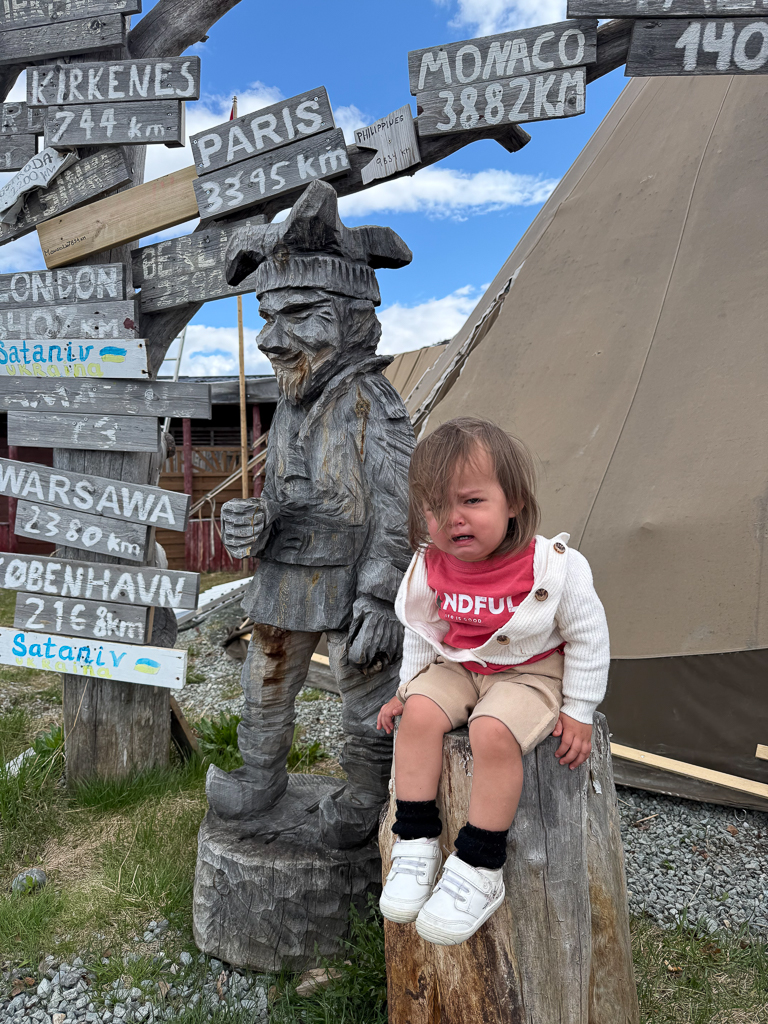
Indie and the troll king at a Sami souvenir stand tent
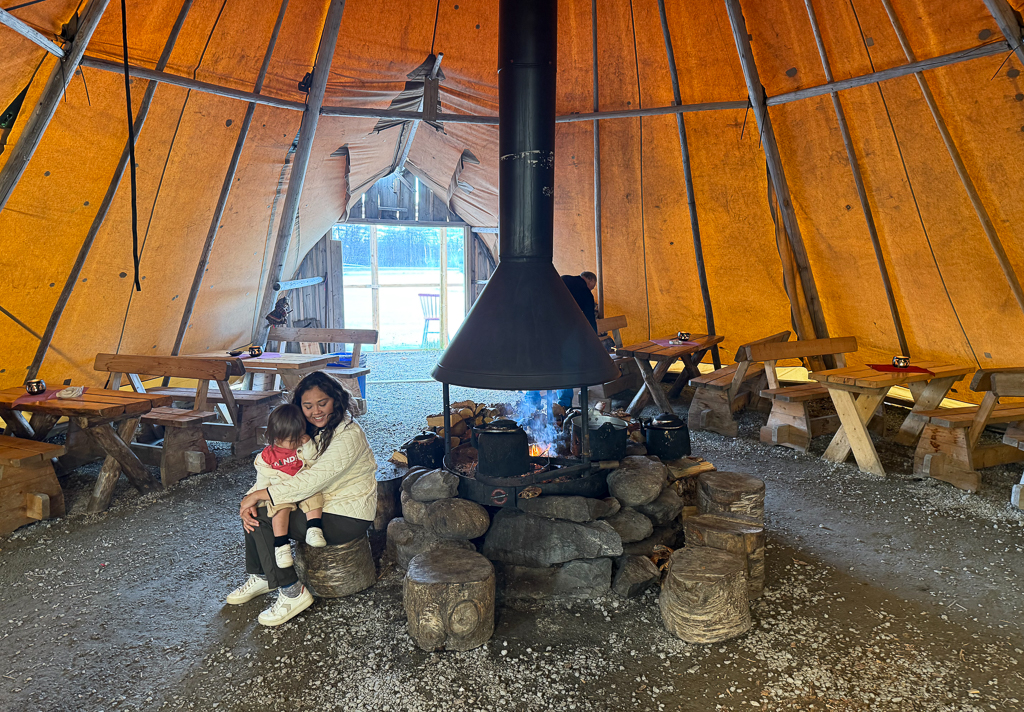
Warming up in a Sami tent
Hard Goodbye
It was hard to leave Norway.
The landscape here—the fjords, the mountains, the endless sky—offers a kind of beauty that feels otherworldly, yet somehow familiar. It’s easily among the most breathtaking in the world, but for me, it goes deeper than scenery. There’s a family connection that tugs at something quieter, something more personal. Norway doesn’t just impress—it feels like home.
As we boarded our flight and looked out at the Arctic coast one last time, I knew this wouldn’t be the end. We’ll be back. And next time, we’ll bring Indie not just to see the mountains and the reindeer—but to meet the Norwegian relatives she’s connected to through ancestry. To give her not just memories, but roots.

